CWWK M8 MITX 10GbE NAS Motherboard & CPU Review
The CWWK M8 NAS motherboard, equipped with either the Intel Twin Lake N150 or N355 processor, is a compact Mini-ITX platform aimed at advanced home NAS builders and small office users looking for a cost-effective alternative to branded NAS systems. Measuring just 17 x 17 cm, it combines several high-end features such as an onboard 10GbE RJ45 LAN (via the AQC113C controller), dual 2.5GbE Intel i226-V ports, and support for up to eight SATA drives through dual SFF-8643 ports. The board also integrates two M.2 NVMe slots, a DDR5 SO-DIMM memory slot supporting up to 48GB, and a PCIe Gen3 x1 slot for modest expansion. Unlike many low-power ITX boards, the M8 includes support for Wake-on-LAN, PXE boot, and hardware monitoring, which makes it a viable candidate for 24/7 operations and remote deployment scenarios. With its efficient lane distribution—critical for balancing 10GbE, NVMe, SATA, and PCIe simultaneously—it delivers a level of I/O flexibility not commonly found at this price point, particularly in the sub-$300 range.
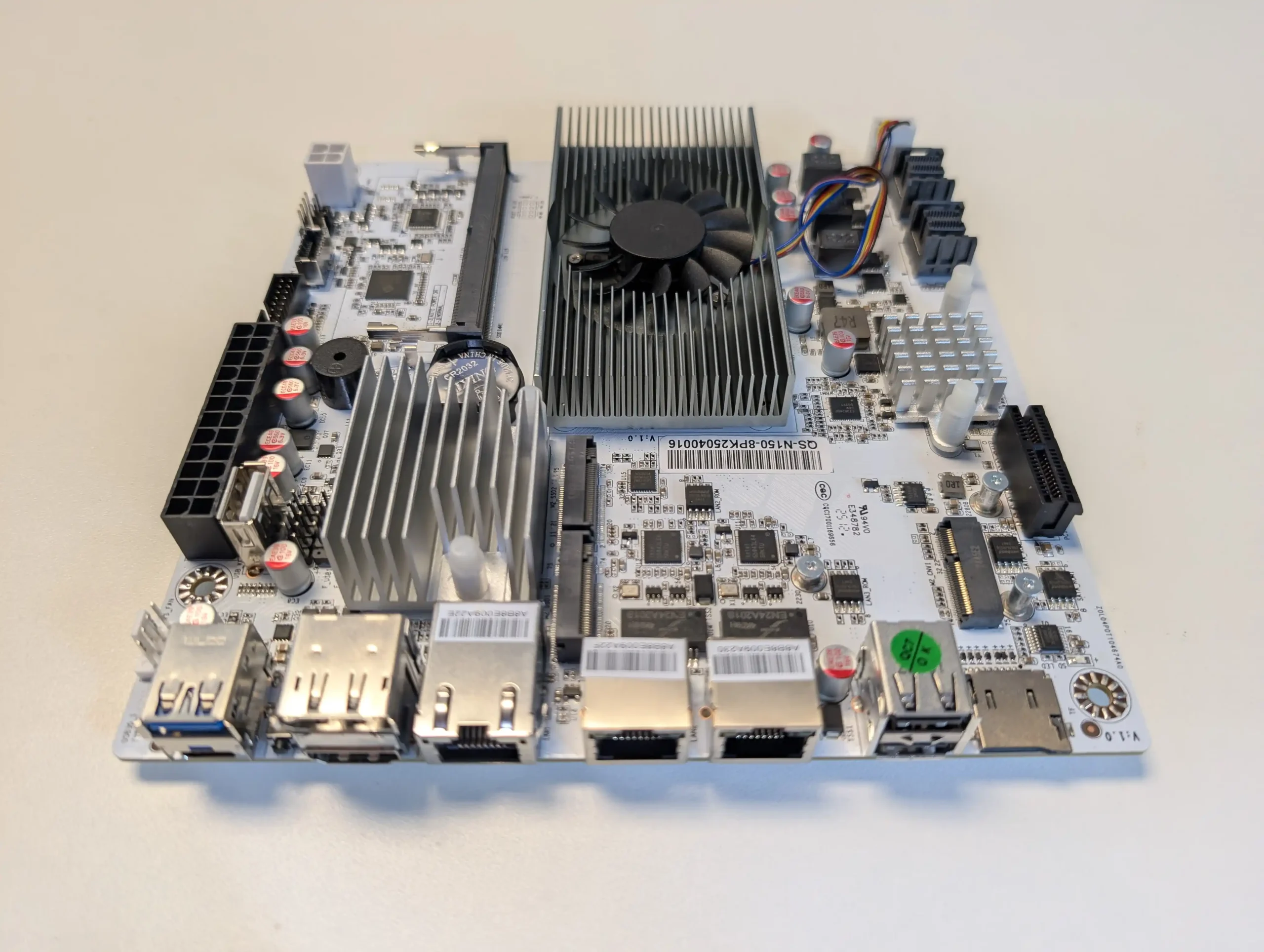
CWWK M8 10GbE NAS Mobo – Quick Conclusion
The CWWK M8 NAS motherboard strikes a practical balance between performance, expandability, and power efficiency, making it a compelling choice for DIY NAS builders looking for 10GbE capability without the complexity or cost of larger platforms. With support for up to eight SATA drives via dual SFF-8643 connectors, dual NVMe slots, and a DDR5 SO-DIMM socket (up to 48GB), it delivers a surprising level of storage flexibility in a compact Mini-ITX form factor. Performance across the 10GbE port is strong—achieving near-saturation read speeds and respectable write throughput—while NVMe and SATA access remain consistent thanks to a careful PCIe lane allocation strategy. Power draw remains modest, even when fully populated with drives and expansion cards, reinforcing its suitability for 24/7 deployments. However, limitations like Gen3 x1 NVMe speeds, a single RAM slot, and shared PCIe/E-Key lane usage should be considered by those seeking maximum expansion or high-end performance. Still, for its price, pre-installed CPU, and strong open-source OS compatibility, the M8 offers an unusually capable base for home servers, backup targets, or even Plex and Proxmox environments.
| Where to Buy? |
CWWK M8 10GbE NAS Mobo – Design
The physical design of the CWWK M8 motherboard is centered around the Mini-ITX standard, maintaining a compact 17 x 17 cm footprint that caters to space-conscious NAS builds. Despite its small form factor, the layout is methodically structured to maximize accessibility and airflow. Key components such as the dual SFF-8643 ports, NVMe slots, and RAM socket are positioned for easy cable routing and minimal overlap.
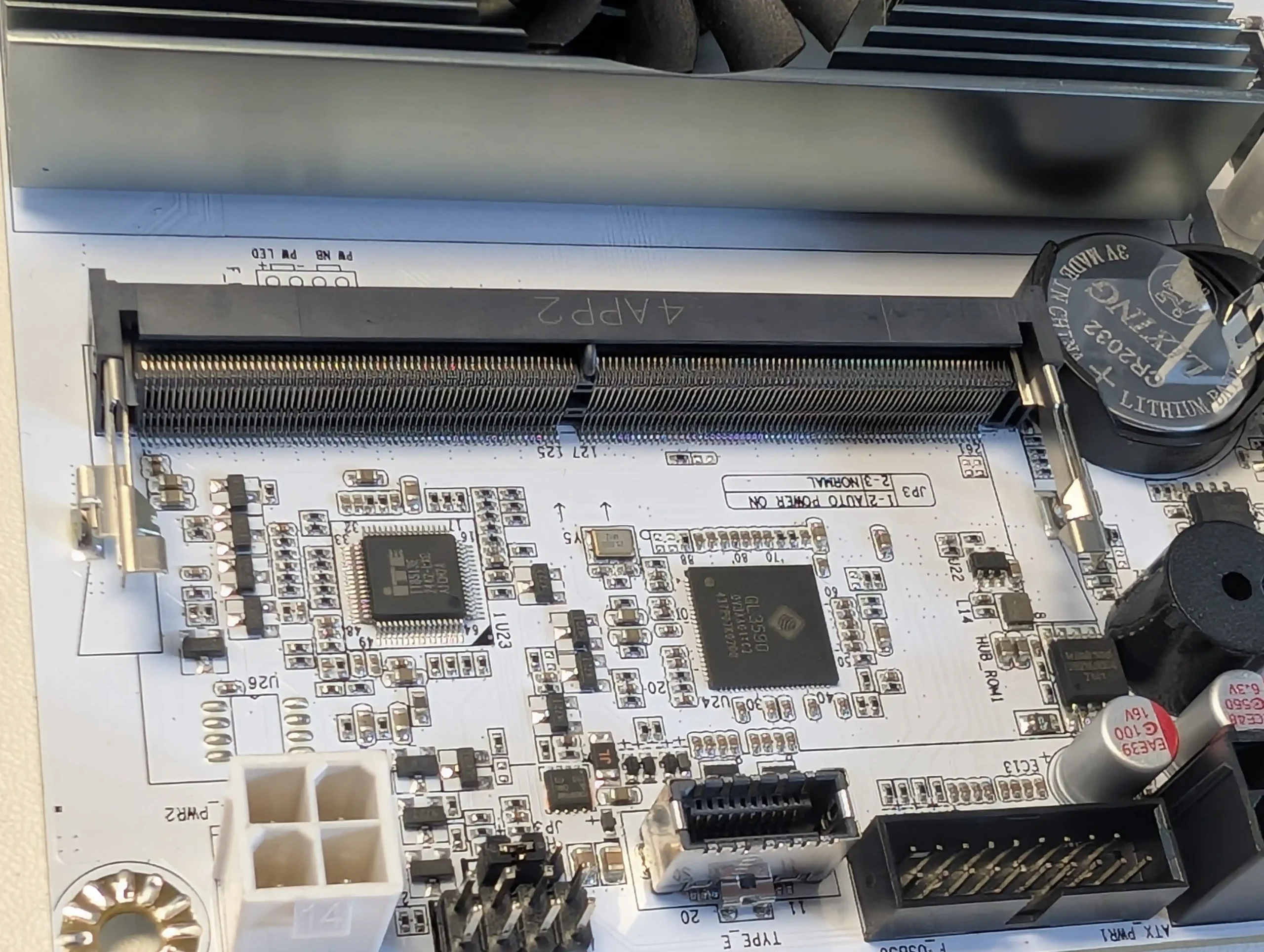
The CPU arrives pre-installed with a low-profile ball-bearing cooler, which is sufficient for the low 6W TDP of the N150 processor. There’s also a system fan header onboard with PWM support, allowing for basic thermal management in enclosed NAS chassis. The board is finished in a neutral white PCB, aligning with recent CWWK trends that blend aesthetic minimalism with function-first engineering.

Storage expansion is one of the most defining elements of the M8. It features dual SFF-8643 ports that, with breakout cables, provide connectivity for up to eight SATA III (6Gbps) drives.
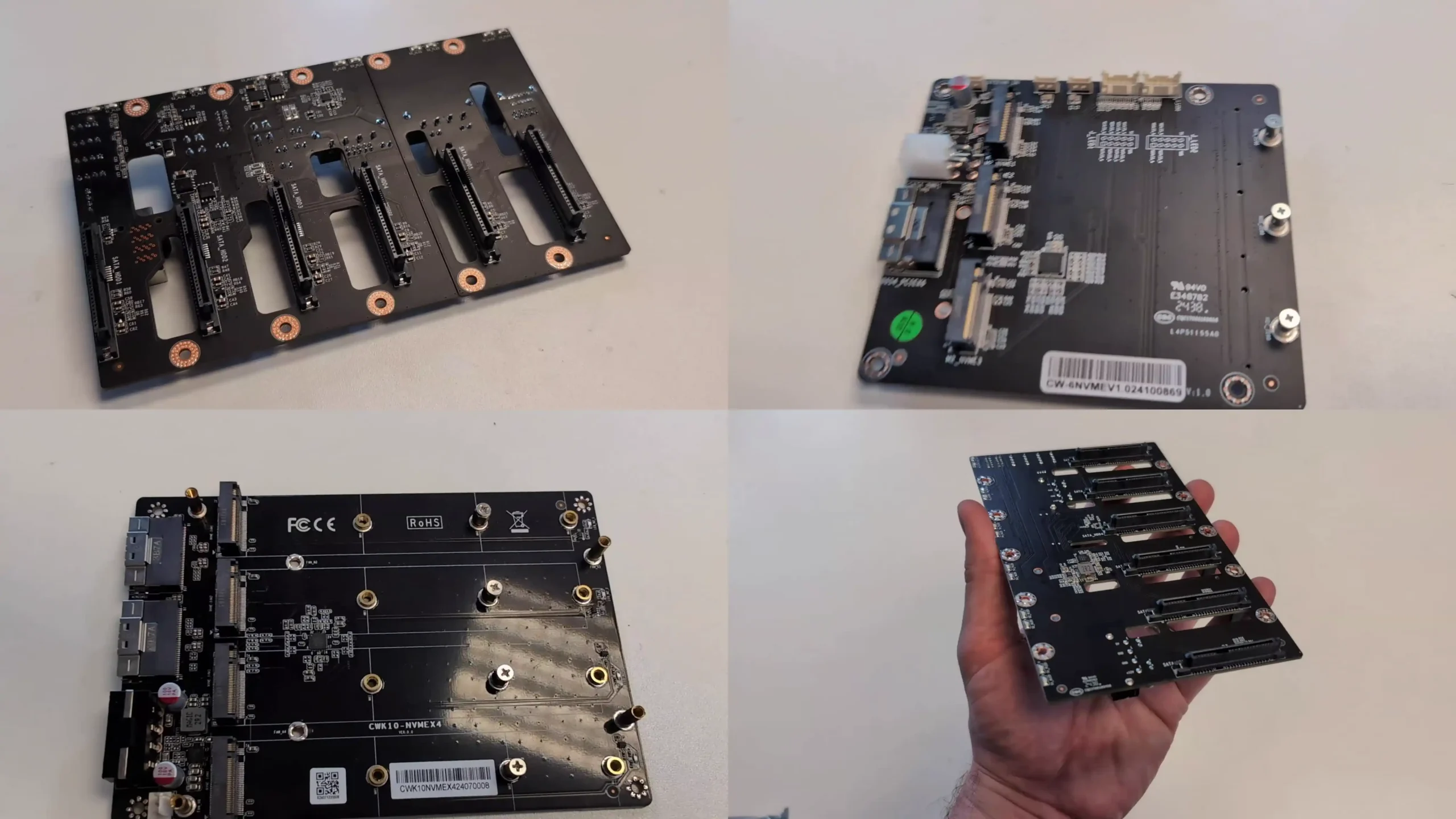
These connectors are routed through independent ASM1164 controllers, each on a dedicated PCIe Gen3 x1 lane, ensuring that drive traffic is not bottlenecked through a single controller.
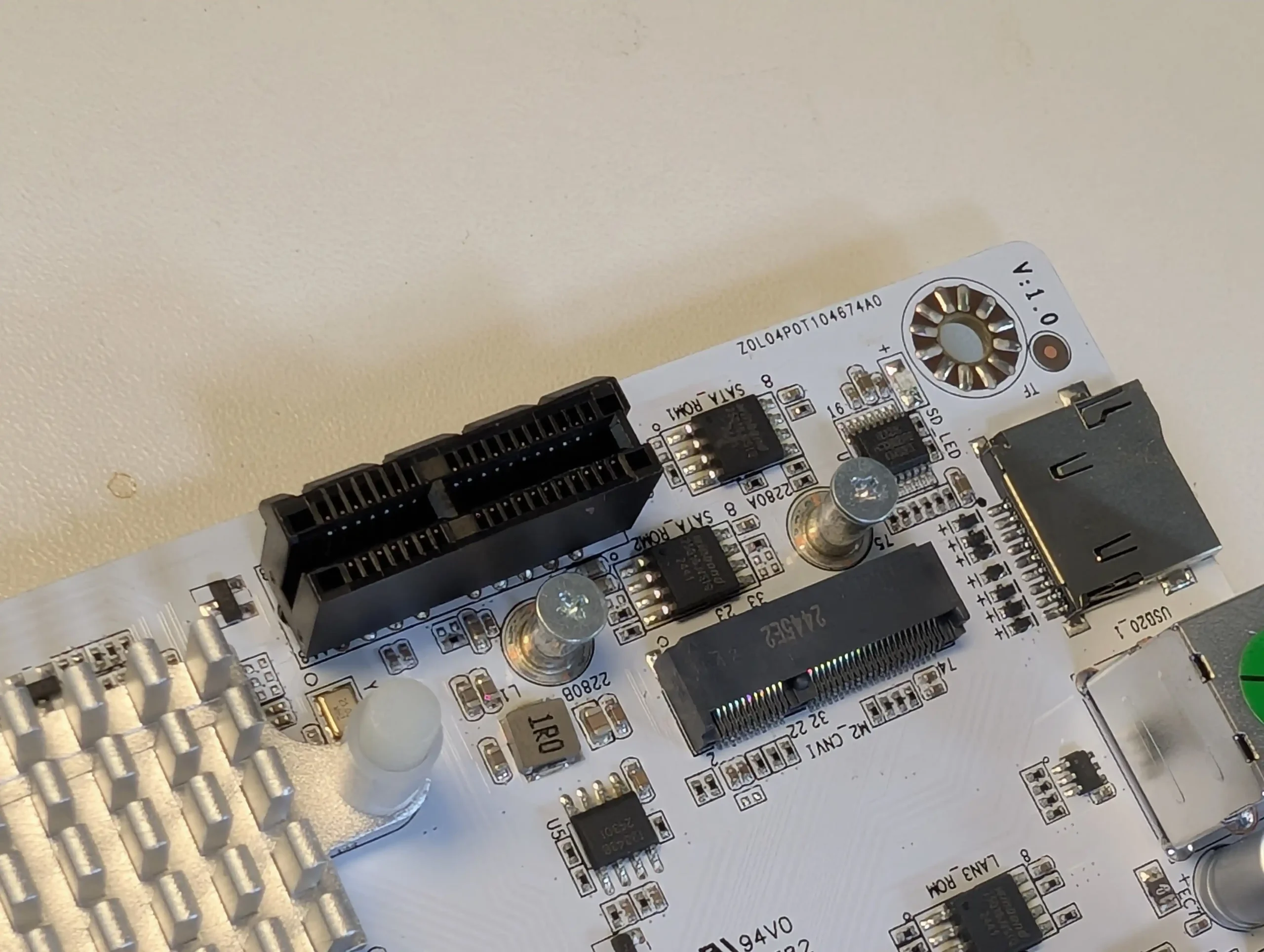
This separation also means users can confidently deploy SSDs or mixed SSD/HDD arrays without major performance drops under load. The board supports RAID configurations at the OS level via TrueNAS or Unraid, and is capable of delivering reliable throughput for multi-drive setups including RAID-Z, RAID5, or JBOD.

In addition to traditional SATA storage, the board includes two M.2 NVMe 2280 slots, each operating at PCIe Gen3 x1. While this limits peak performance to around 900MB/s per slot, it is sufficient for cache drives or SSD-based boot volumes, especially in NAS environments where latency and parallel IOPS matter more than raw sequential throughput. The placement of the NVMe slots, one top-side and one underside, helps distribute heat and gives builders flexibility in cooling strategy. Both slots are directly accessible, and installation doesn’t require removing other components, which is particularly useful during upgrades or replacements.

Storage scaling is enhanced through the modularity of the board’s SFF-8643 interfaces. As discussed in your review, these ports can be adapted not just to standard SATA breakouts but also to additional M.2 or U.2 devices with the correct adapter cards. This creates potential for hybrid NAS setups—using SATA for bulk data storage and NVMe for hot data or VM usage. Such versatility in drive mapping is rarely offered at this price point, and makes the board viable not only for home media servers but also for lab environments or light virtualized storage nodes.

One lesser-known but practical addition is the inclusion of a MicroSD (TF) slot on the PCB. While it’s not ideal for installing major OS platforms like TrueNAS Core, it can be useful for loading bootloaders such as Unraid or for system config backups. Importantly, the TF slot is recognized natively by most operating systems and appears as a usable storage device without requiring extra drivers. It also enables simple out-of-band recovery or local snapshot scripts in more advanced workflows. Combined with the available internal USB port, the board allows multiple low-impact boot or recovery paths to coexist alongside primary storage deployments.
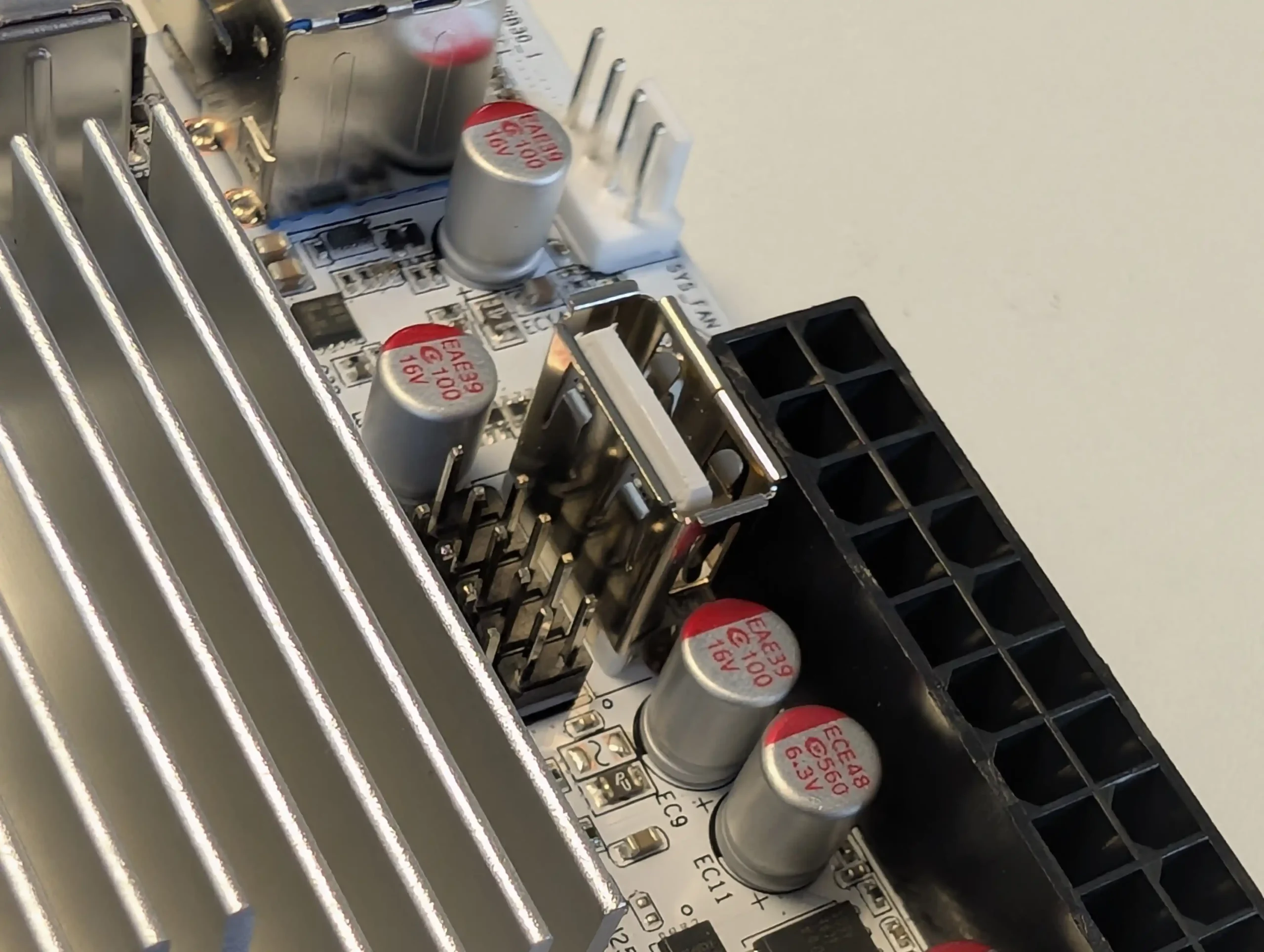
CWWK M8 10GbE NAS Mobo – Ports and Connections
The CWWK M8 motherboard is equipped with a well-rounded selection of external and internal I/O ports that support a broad range of NAS and server use cases. Most notably, it includes one 10GbE RJ45 port powered by the AQC113C controller and two additional 2.5GbE ports via Intel i226-V chips.
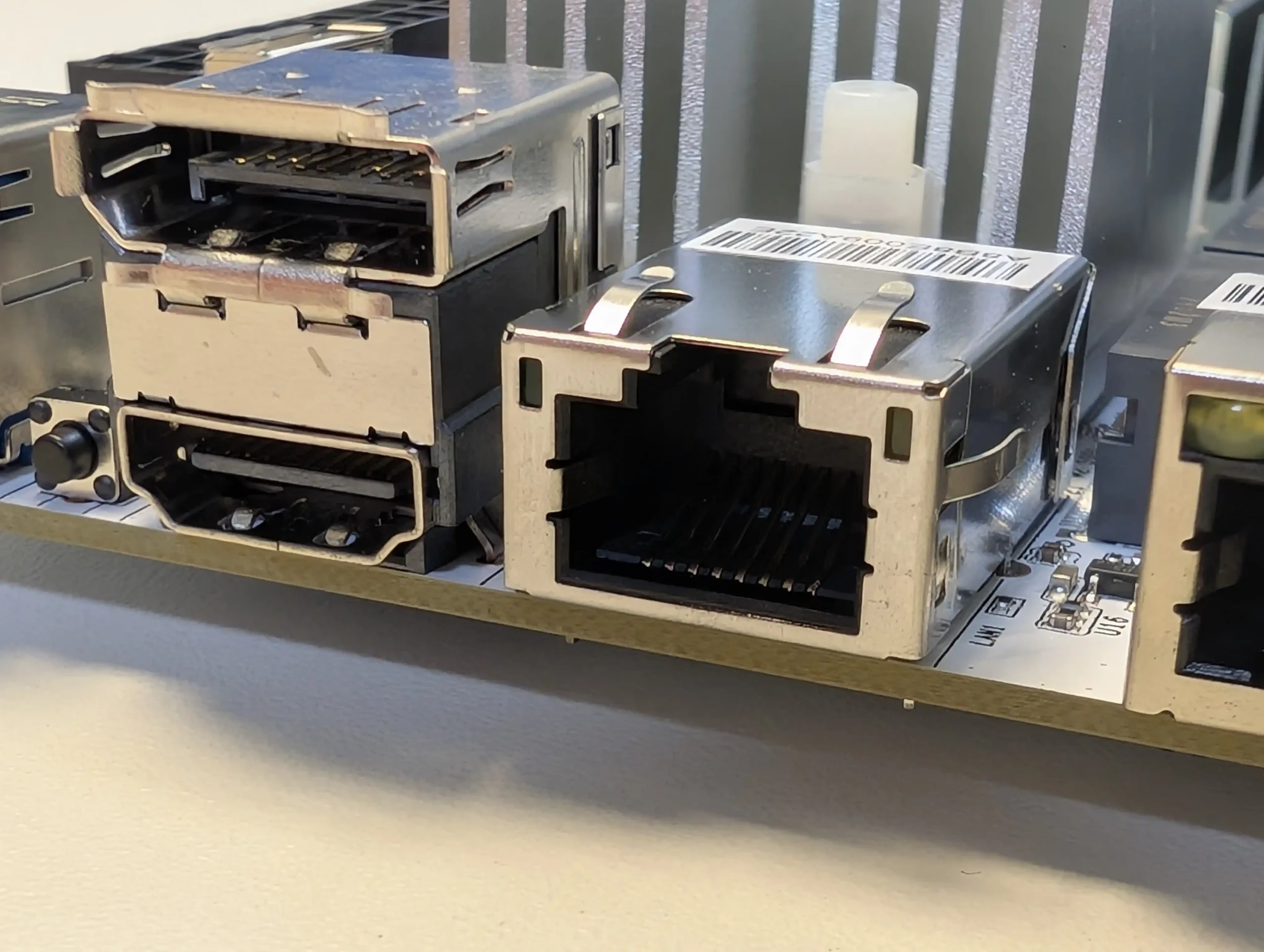
These networking options allow the board to operate in multiple roles simultaneously, such as high-speed file sharing over 10GbE while maintaining service management or redundancy via the dual 2.5GbE ports. The inclusion of Intel network controllers ensures wide compatibility with open-source operating systems like TrueNAS and Unraid, as well as ESXi and PVE, making it a suitable base for software-defined networks, VLAN tagging, or bonded interface configurations.
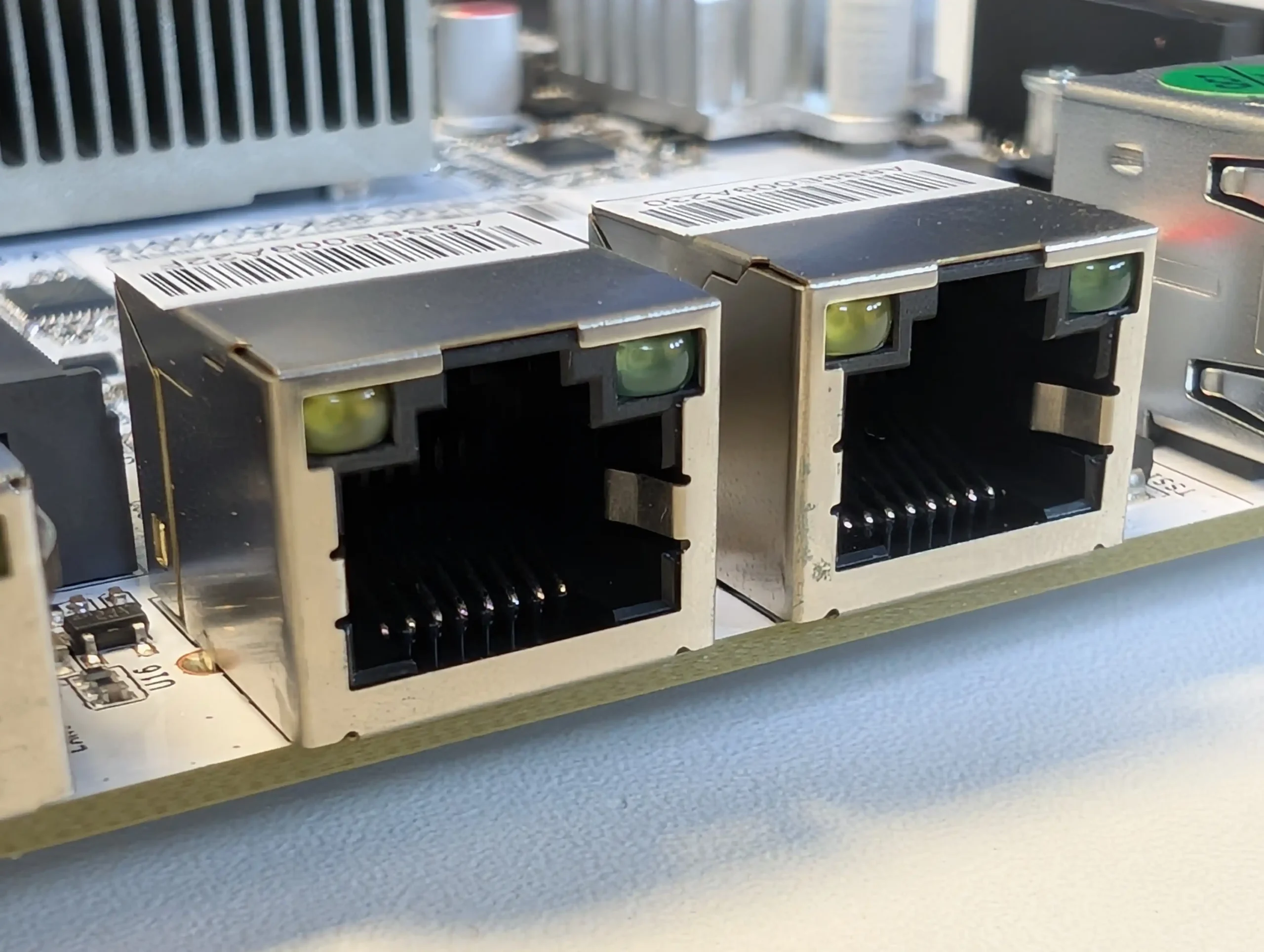
On the USB front, the M8 provides a combination of high-speed and legacy options. It includes 1× USB Type-C (10Gbps) and 1× USB 3.2 Gen2 Type-A (10Gbps) ports for external storage or fast USB peripherals. There are also 2× USB 2.0 Type-A ports located at the rear I/O and an internal USB 2.0 header, which is useful for OS boot drives such as Unraid.
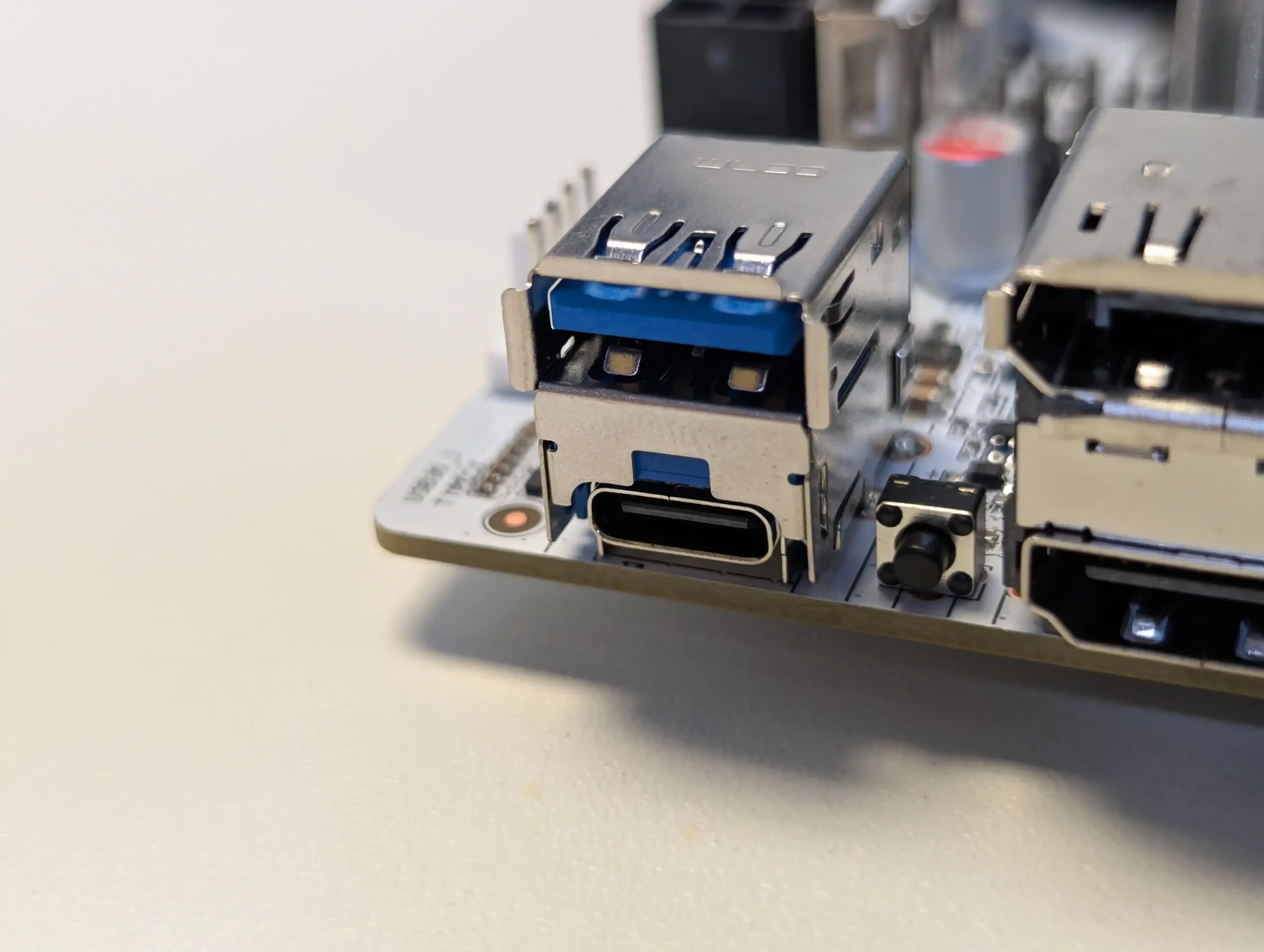
Internally, the board also features a USB 3.0 header and a Type-E header, allowing front-panel USB 3.x support if the chassis includes such connectors. These ports give builders the flexibility to attach boot media, backup targets, or even USB-based UPS management tools without additional hardware.
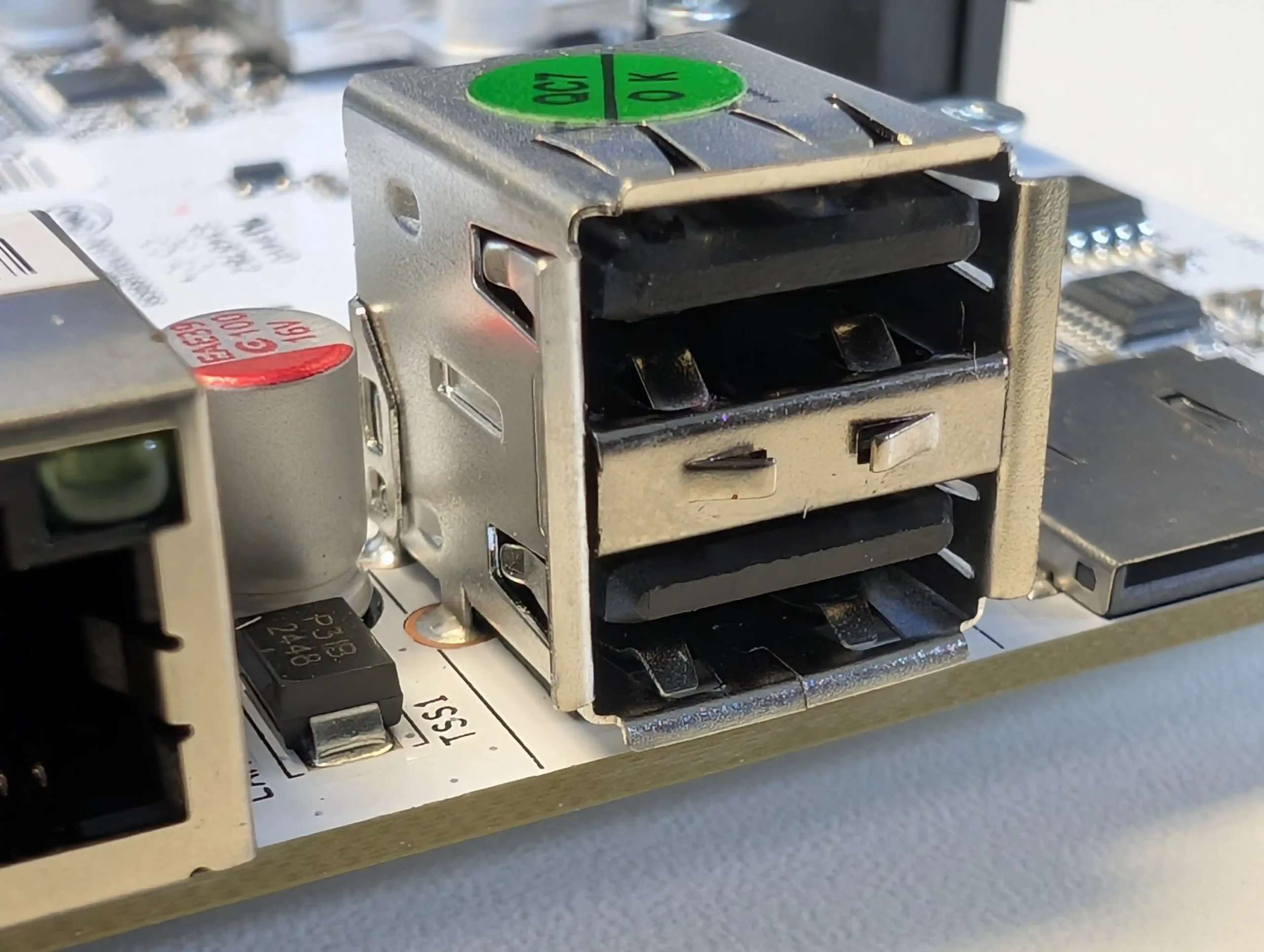
For video output and direct display use, the M8 includes 1× HDMI 2.0 and 1× DisplayPort 1.4, both capable of 4K@60Hz output. These are connected via the integrated UHD graphics included with the N150/N355 CPU. While these outputs are generally not essential in a headless NAS environment, they provide value in cases where the system is used as a hybrid HTPC/NAS, or when diagnostics and BIOS access are needed without SSH or remote management tools. The GPU is also supported for hardware video decoding, making the board a viable base for light Plex or Jellyfin deployments that rely on integrated graphics acceleration.
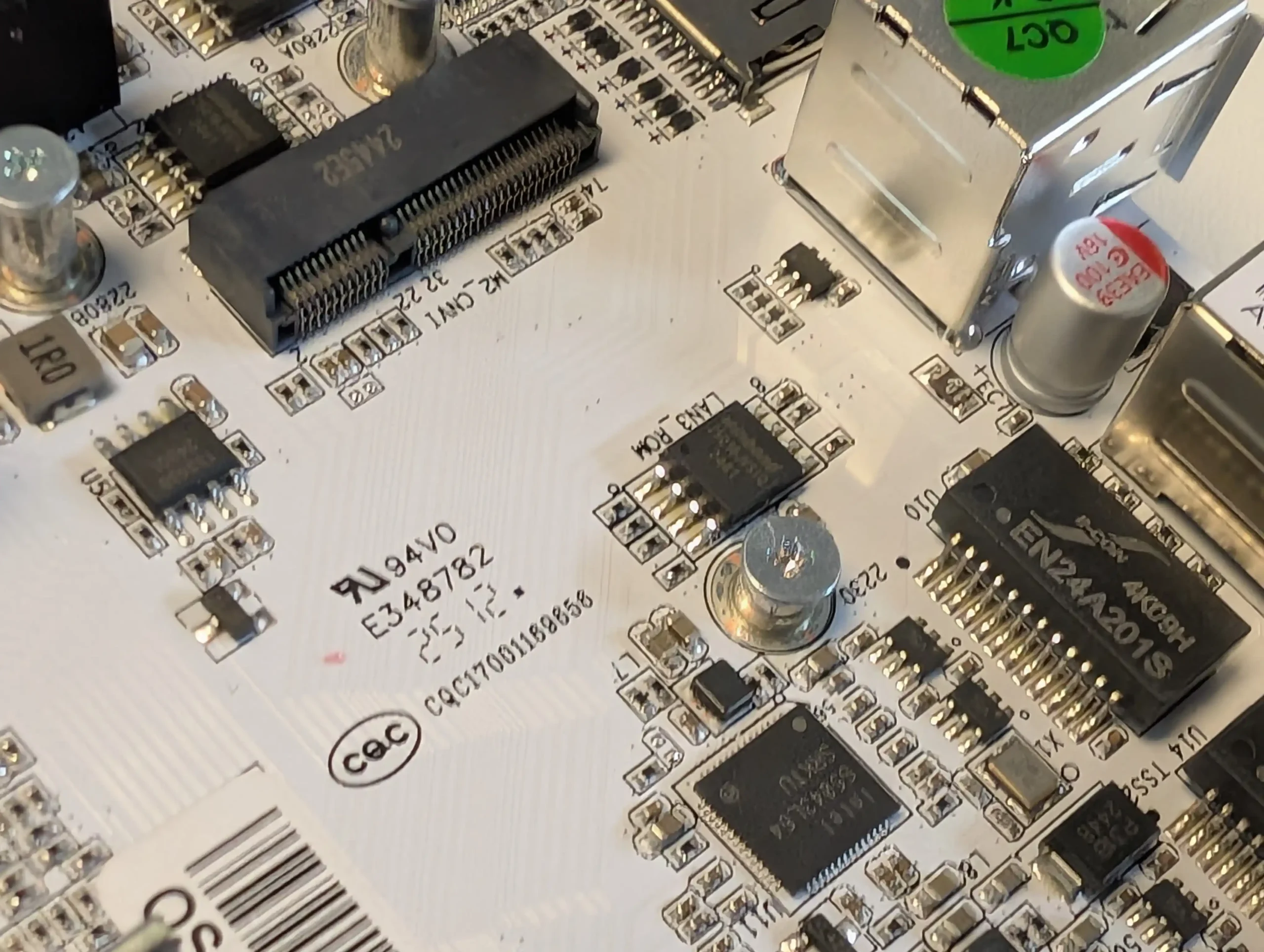
Internally, the board features several headers that further expand its flexibility. Alongside the previously mentioned USB and fan headers, there’s an M.2 E-Key slot for wireless modules, which shares PCIe lanes with the x1 PCIe slot and cannot be used simultaneously. The board also includes an SD card (TF) slot which appears natively in supported OSes—suitable for bootloaders or small backup tasks.
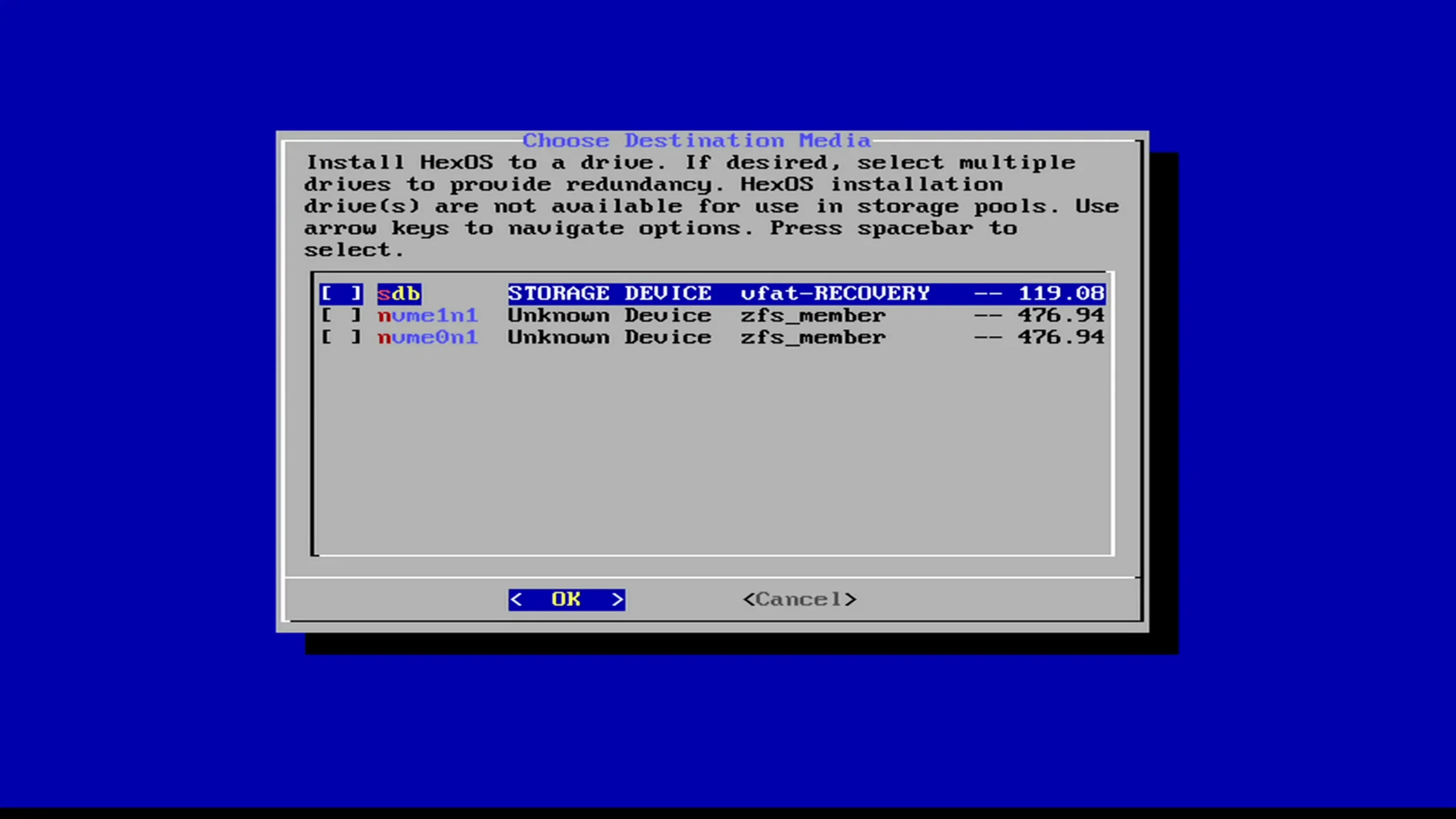
While not suited to high-throughput use, it does provide an alternative storage option in embedded or recovery scenarios. The arrangement and accessibility of these ports are well considered for such a small form factor, ensuring that builders can access almost all essential functionality without relying on riser boards or USB hubs.
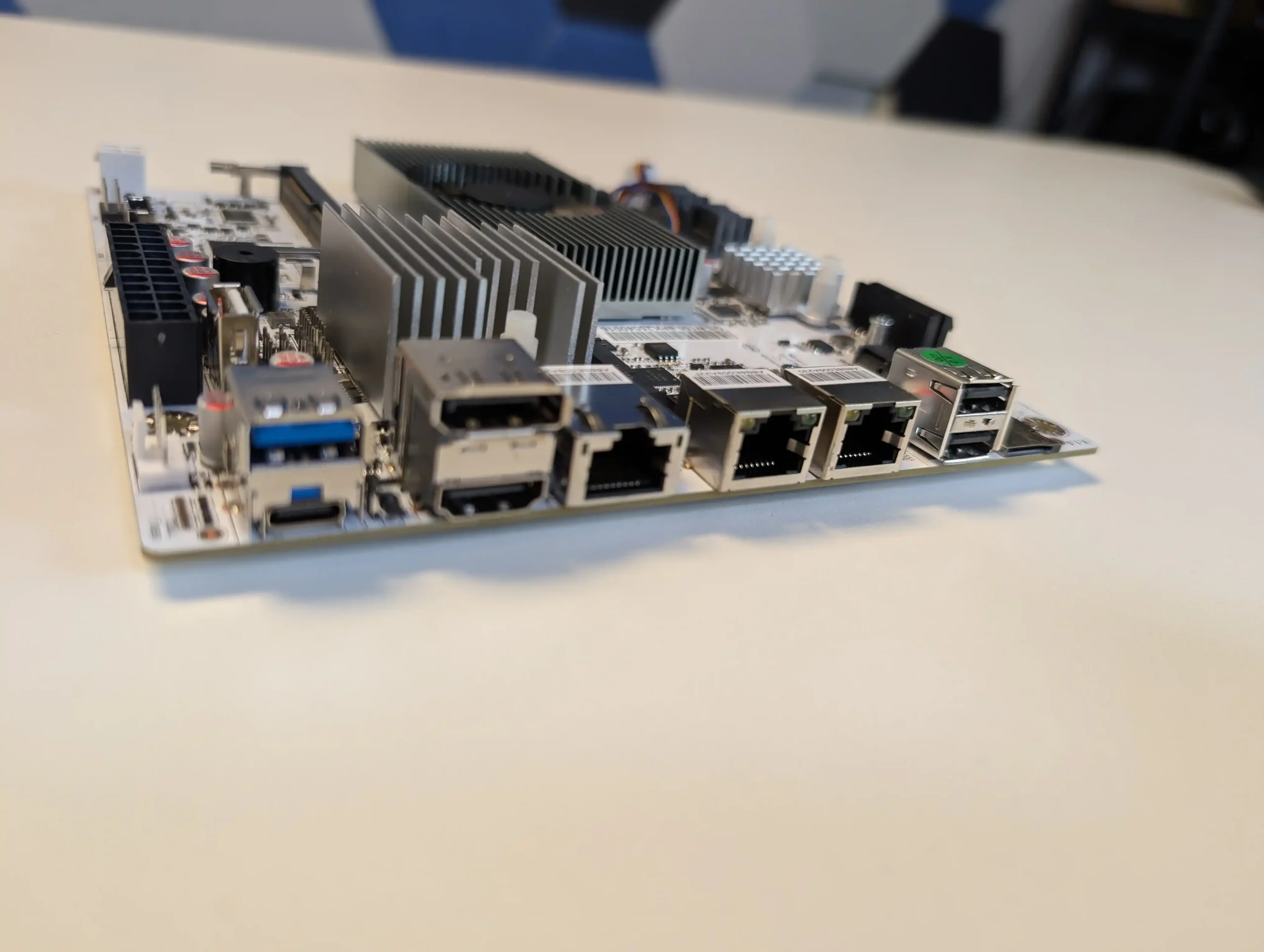
| Interface Type | Details |
|---|---|
| Ethernet Ports | 1× 10GbE RJ45 (AQC113C), 2× 2.5GbE RJ45 (Intel i226-V) |
| USB Ports (Rear) | 1× USB 3.2 Gen2 Type-A (10Gbps), 1× USB-C (10Gbps), 2× USB 2.0 Type-A |
| USB Ports (Internal) | 1× USB 2.0 (boot drive), 1× USB 3.0 header, 1× USB 3.0 Type-E header |
| Display Outputs | 1× HDMI 2.0, 1× DisplayPort 1.4 (both support 4K@60Hz) |
| PCIe Slot | 1× PCIe Gen3 x1 (x4/x8 slot compatible, shared with M.2 E-Key) |
| M.2 Slots | 2× M.2 2280 NVMe (PCIe Gen3 x1), 1× M.2 E-Key for WiFi/BT |
| SD Card Slot | 1× TF (MicroSD) slot (appears as storage device) |
| Fan and Headers | 1× PWM fan header, various USB/F_USB headers for front I/O |
CWWK M8 10GbE NAS Mobo – Internal Hardware
At the heart of the M8 motherboard lies a choice between two Intel Twin Lake processors: the N150 and the N355. The N150 is a quad-core, four-thread CPU with a base architecture derived from the Alder Lake-N family, running at up to 3.6GHz and featuring a modest 6MB cache. It operates at a remarkably low TDP of 6W, making it suitable for passive or semi-passive cooling environments.

The N355, on the other hand, doubles the thread count and bumps performance further, albeit at a slightly higher price. Both CPUs are pre-soldered to the board and arrive with a compact, ball-bearing fan assembly that supports quiet, efficient cooling. These processors are not meant for heavy computation but offer enough power for file server duties, light containerization, and even modest Plex media serving—with the N150 proving capable of 4K playback in testing.
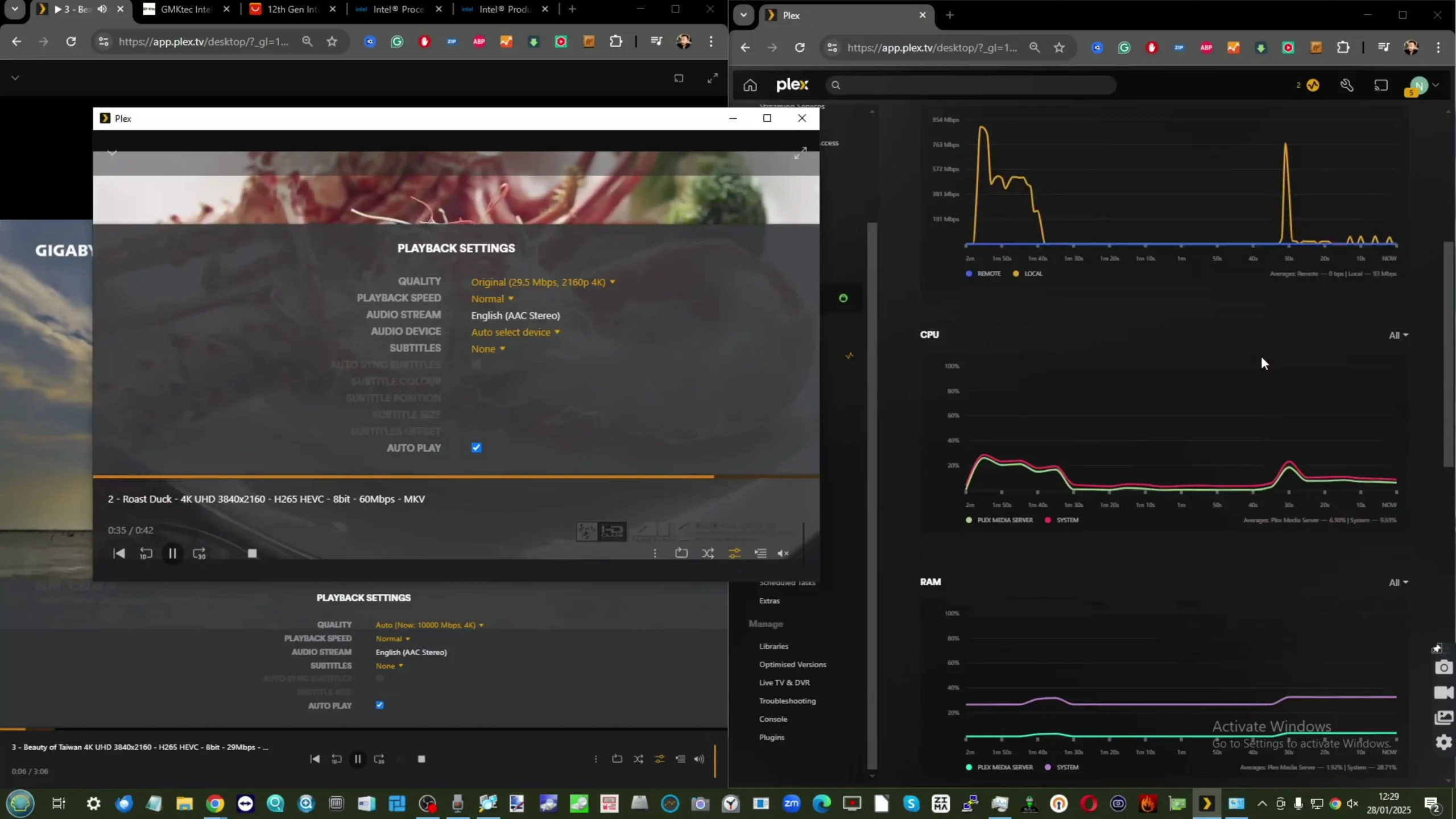
Memory support is handled via a single DDR5 SO-DIMM slot, officially supporting up to 48GB at 4800MHz. While dual-channel operation is not available, DDR5’s higher base bandwidth helps compensate for this limitation in real-world usage. The board accepts standard non-ECC modules and will clock down any faster memory to the platform’s 4800MHz limit.
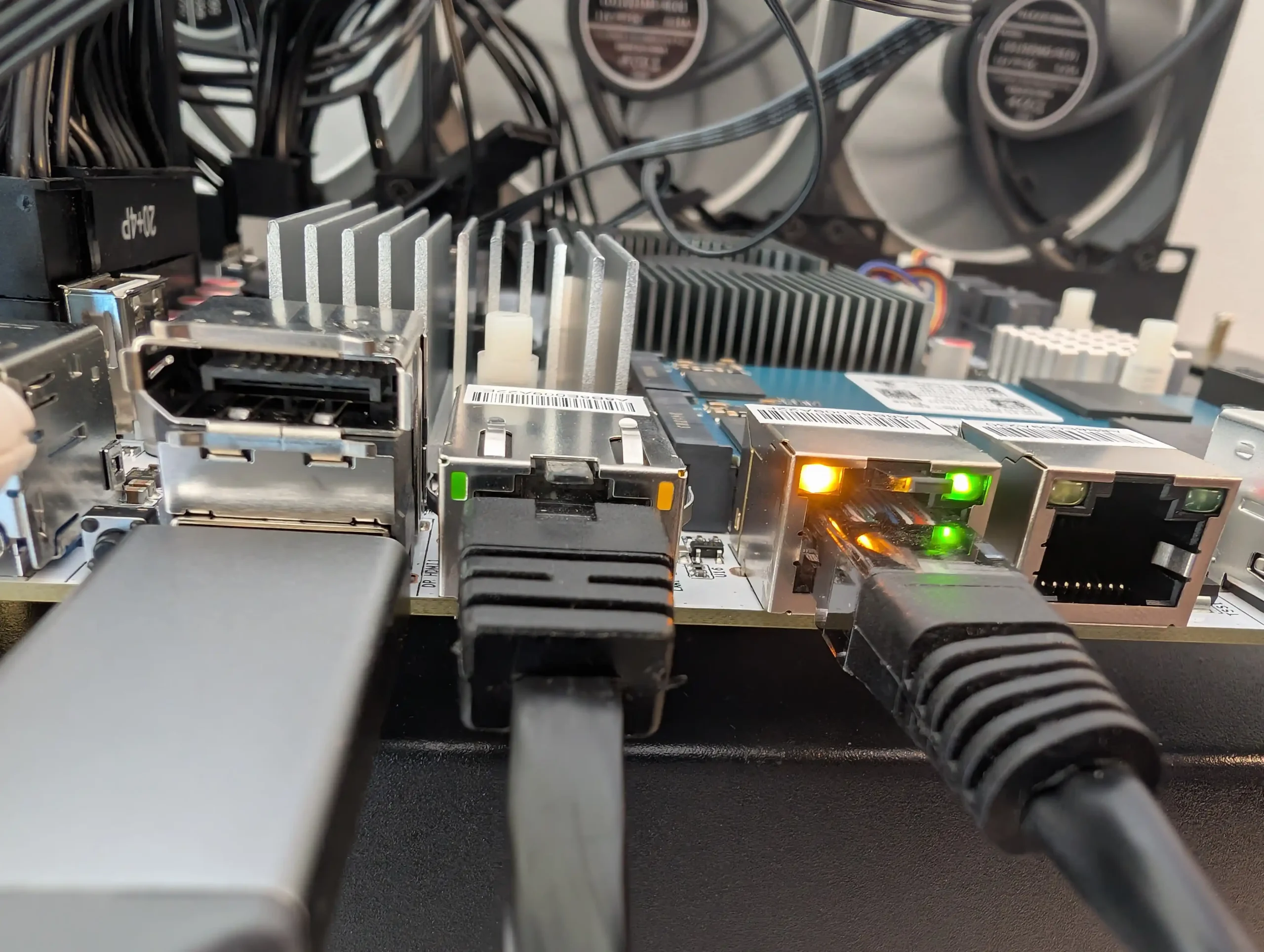
For NAS and virtualization users, this constraint is acceptable, though power users may note that memory upgrades are capped to a single slot. That said, 32GB or 48GB configurations are more than adequate for common use cases like running TrueNAS Scale with Docker containers, or spinning up a few VMs in Proxmox.
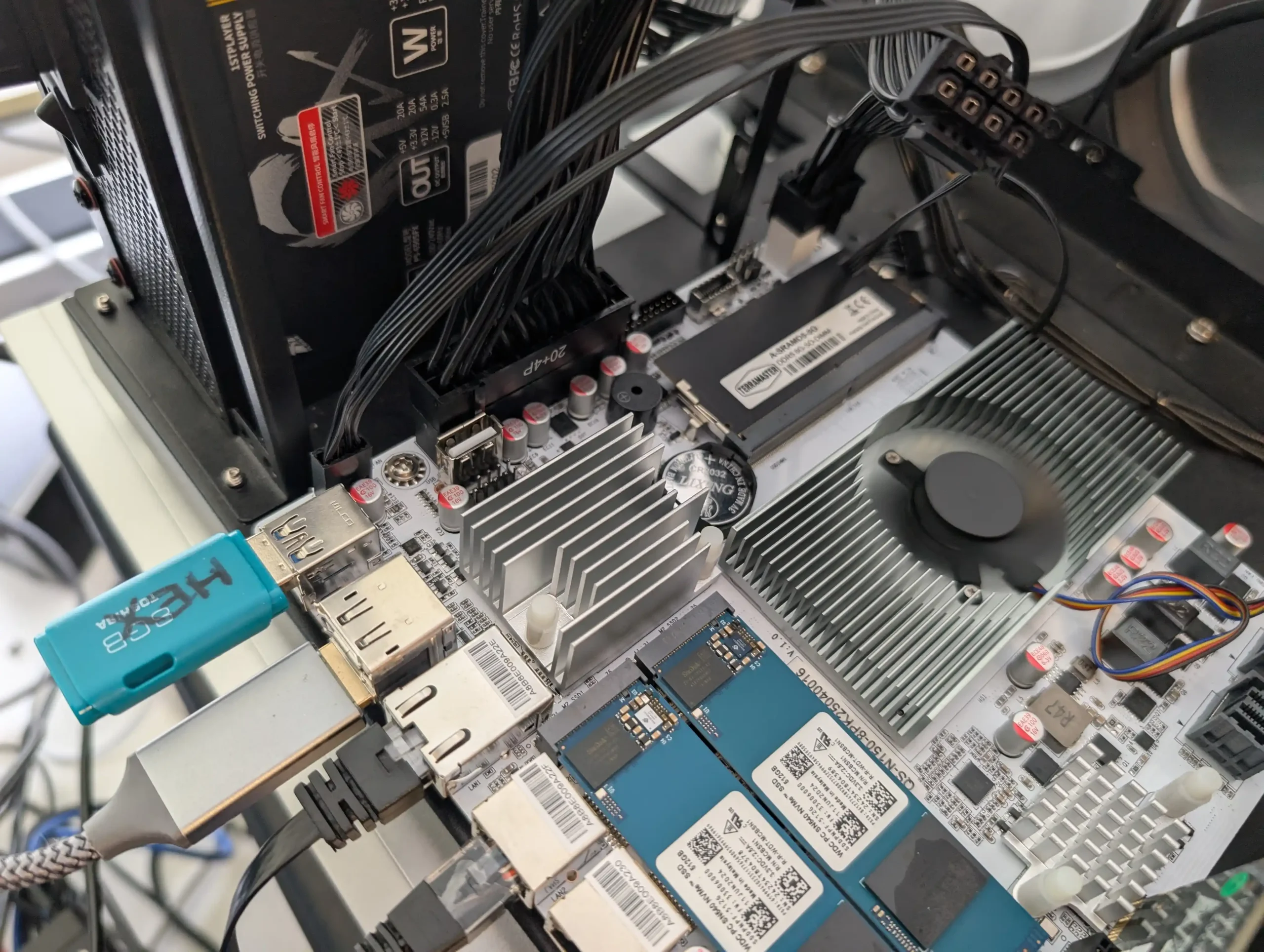
The board’s PCIe lane distribution is particularly deliberate given the constraints of the Twin Lake architecture, which provides just 9 usable PCIe lanes. Despite this, the M8 balances connectivity by allocating PCIe Gen3 x2 bandwidth to the 10GbE port, ensuring full 10Gbps throughput with bandwidth overhead. The SATA controllers each receive dedicated PCIe Gen3 x1 lanes, and each M.2 NVMe slot is similarly mapped at x1 speed.
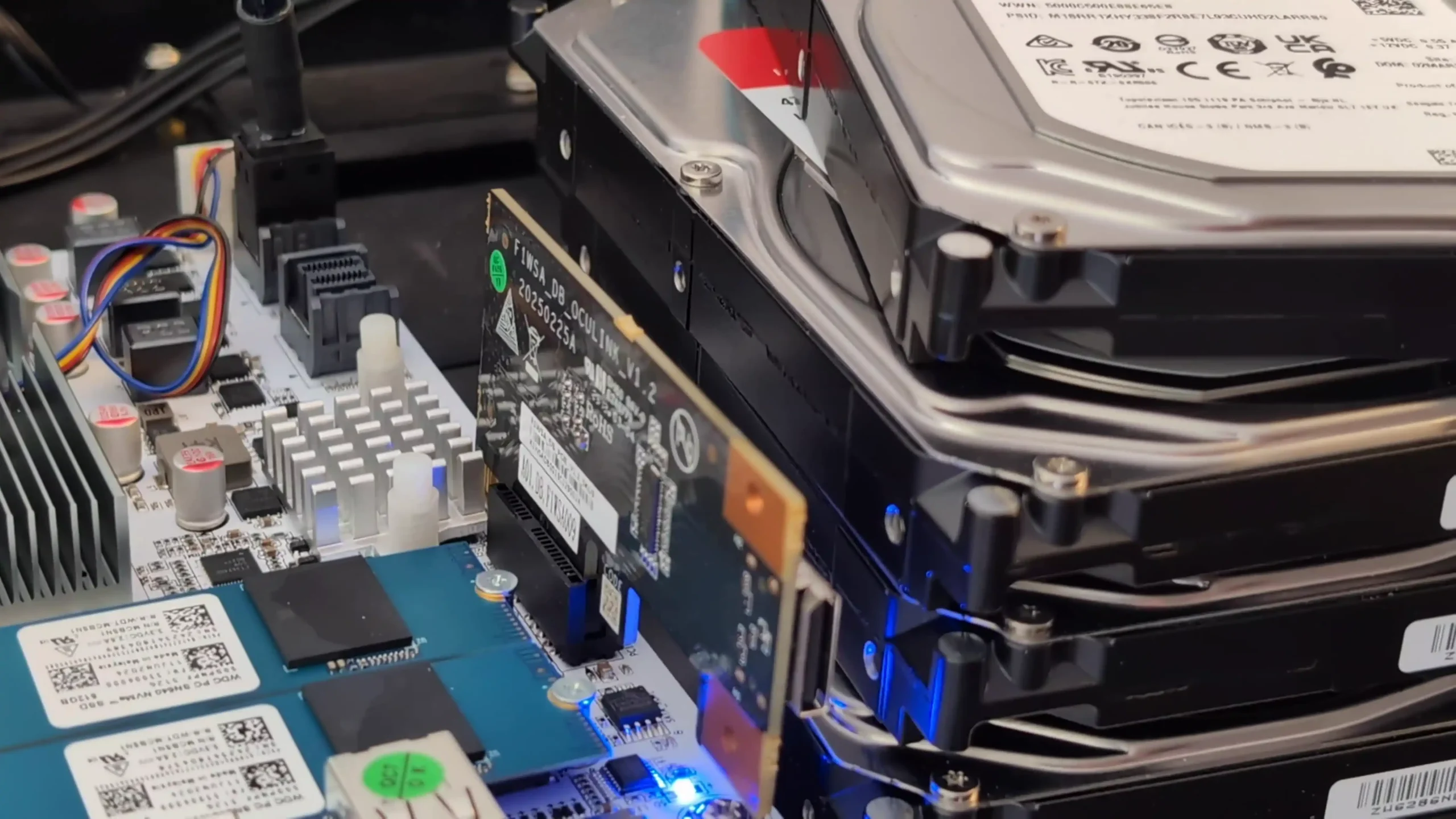
The remaining lane is shared between the M.2 E-key (for Wi-Fi/BT modules) and the physical PCIe x1 expansion slot. This means that users must choose between Wi-Fi upgrades or additional PCIe peripherals—a typical tradeoff on ITX boards, but worth noting during build planning.
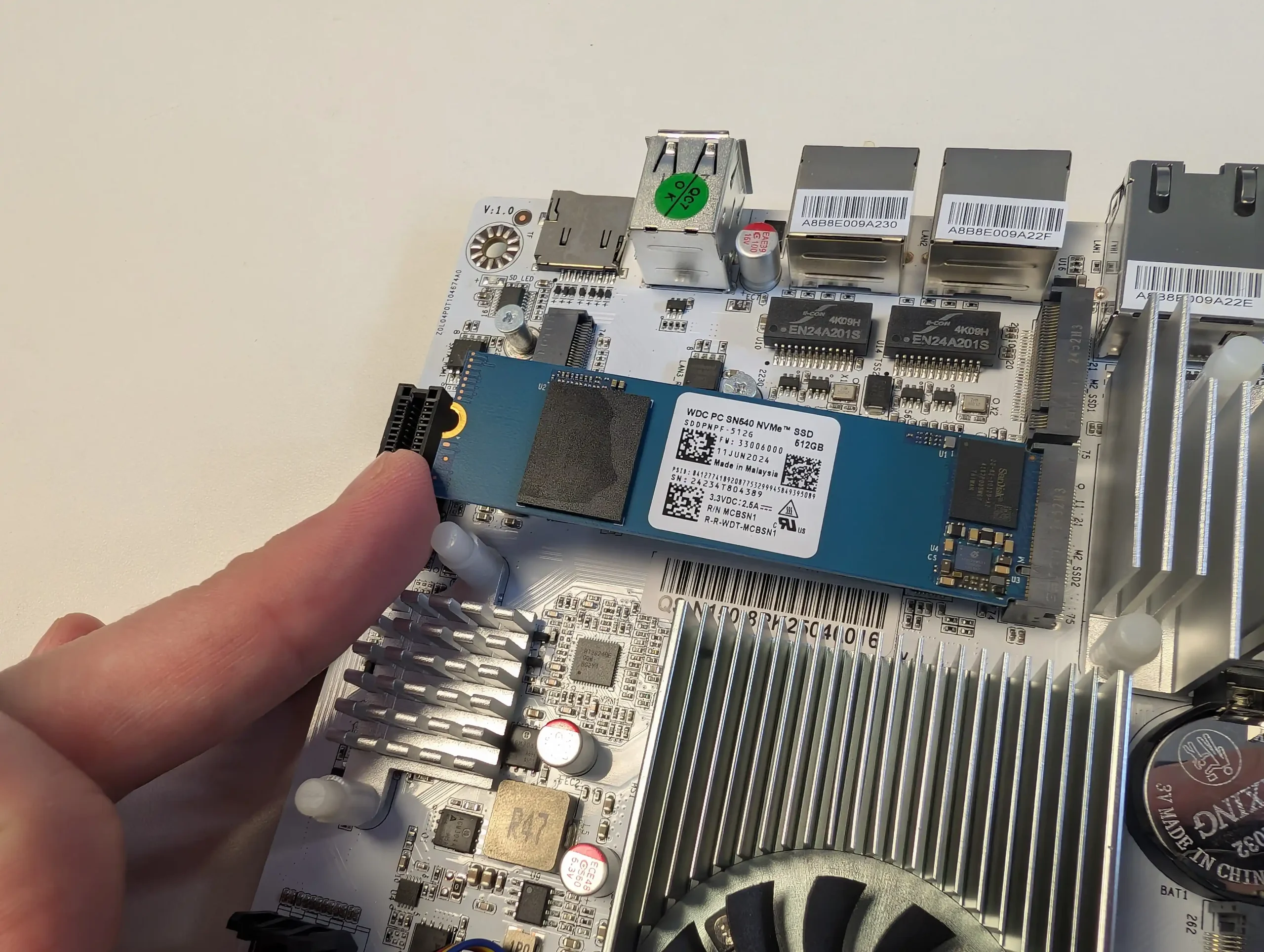
From a system management perspective, the board supports UEFI-only boot modes and includes features such as Auto Power-On, Scheduled Power-On, PXE boot, Wake-on-LAN, and Secure Boot, making it suitable for remote deployment or integration into managed environments. The board includes thermal monitoring via BIOS and OS-level tools, with fan control limited to one system fan header supporting PWM. These features, while basic, are sufficient for home server use or edge deployment in micro data centers. The compact ITX layout also makes the board a candidate for embedded use in custom NAS chassis or OEM enclosures with constrained airflow or proprietary mounting.
| Component | Details |
|---|---|
| CPU Options | Intel N150 (4C/4T, 3.6GHz, 6W TDP), Intel N355 (8C/8T, higher performance) |
| Memory | 1x DDR5 SO-DIMM, up to 48GB (4800MHz), non-ECC |
| Chipset/Lanes | Intel Twin Lake SoC, 9 PCIe Gen3 lanes total |
| NVMe Storage | 2x M.2 2280 NVMe (PCIe Gen3 x1 each) |
| SATA Support | 2x SFF-8643 (8x SATA III via breakout cables, each on ASM1164 controller) |
| PCIe Expansion | 1x PCIe Gen3 x1 slot (shared with M.2 E-Key) |
| WiFi Module Slot | 1x M.2 E-Key (2230) for Wi-Fi/BT (shares lane with PCIe slot) |
| Boot Features | UEFI-only, Auto Power-On, Wake-on-LAN, PXE boot, Secure Boot |
| Fan Support | 1x PWM system fan header, bundled CPU fan |
CWWK M8 10GbE NAS Mobo – Performance and Power Tests
During benchmarking and real-world tests, the N150-based M8 motherboard demonstrated performance levels consistent with expectations for an ultra-low-power NAS platform. Sequential read speeds over the 10GbE interface approached saturation during synthetic ATTO Disk Benchmark tests, particularly with a 256MB block size, where throughput consistently exceeded 950MB/s.
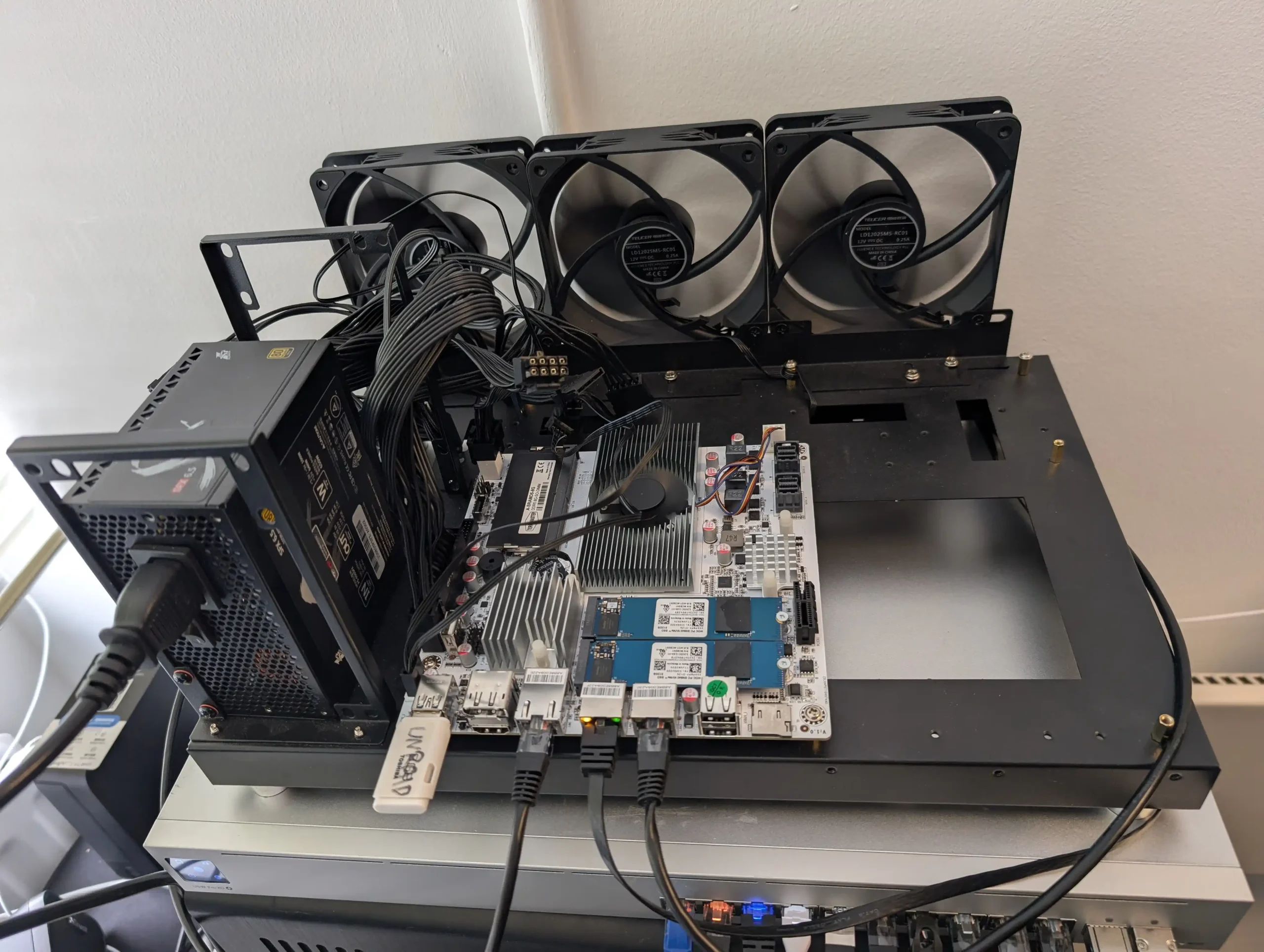
Write performance, however, plateaued slightly lower, averaging between 650–700MB/s for 1GB and 4GB file tests. These figures are typical for systems utilizing Gen3 x1 NVMe SSDs and efficiency-focused CPUs like the N150, where write-intensive operations are more limited by CPU capability than disk throughput. Larger transfers or workloads involving compression will see slightly more variation, but in most scenarios, read performance remained stable and consistent.
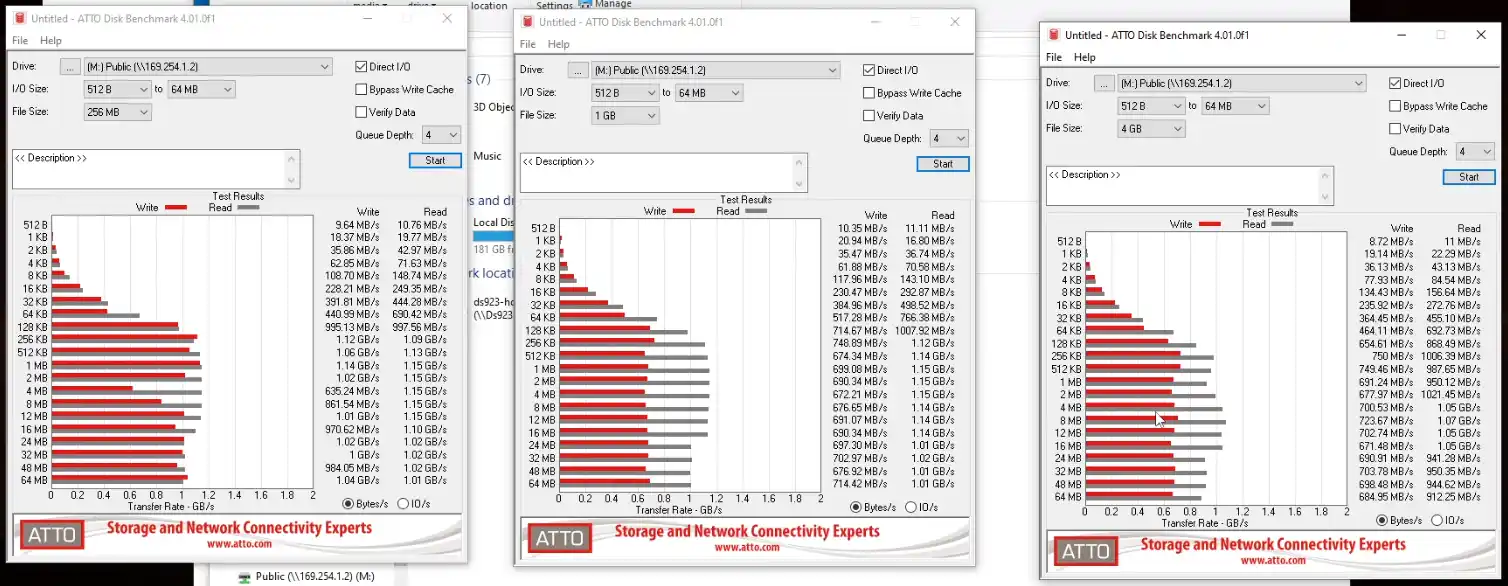
Using a RAID 1 array of Seagate IronWolf drives connected via the dual SFF-8643 SATA ports, the board achieved average write speeds of 550–580MB/s, with occasional peaks in read performance reaching up to 800MB/s, though these were not sustained.
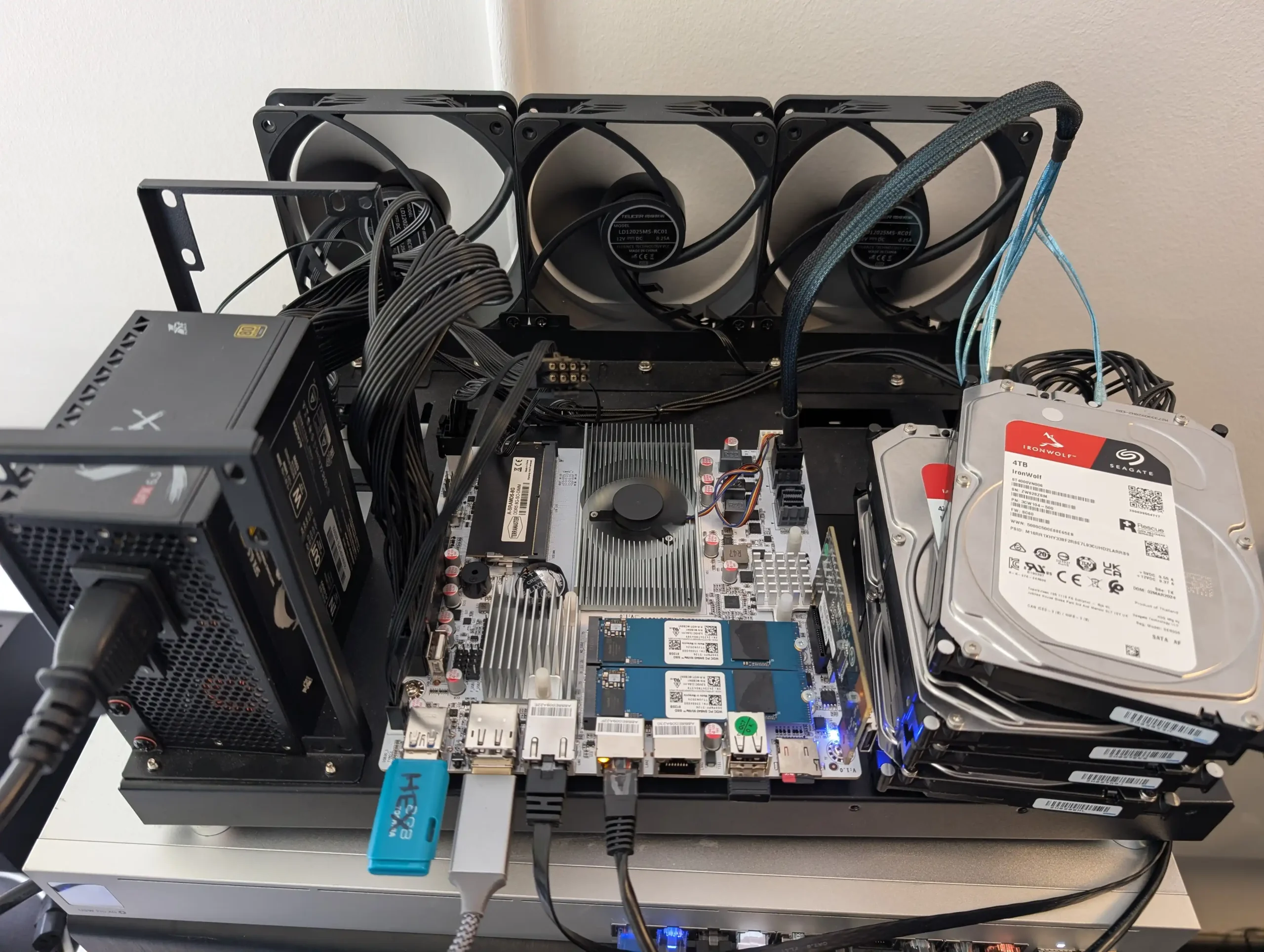
These results reflect the benefit of having each SATA group routed through a separate ASM1164 controller, ensuring that bandwidth isn’t choked under RAID configurations or multi-drive reads. In practical terms, this makes the board well-suited for file-serving tasks, Time Machine backups, or media library hosting, with no obvious contention across interfaces during simultaneous read/write operations.
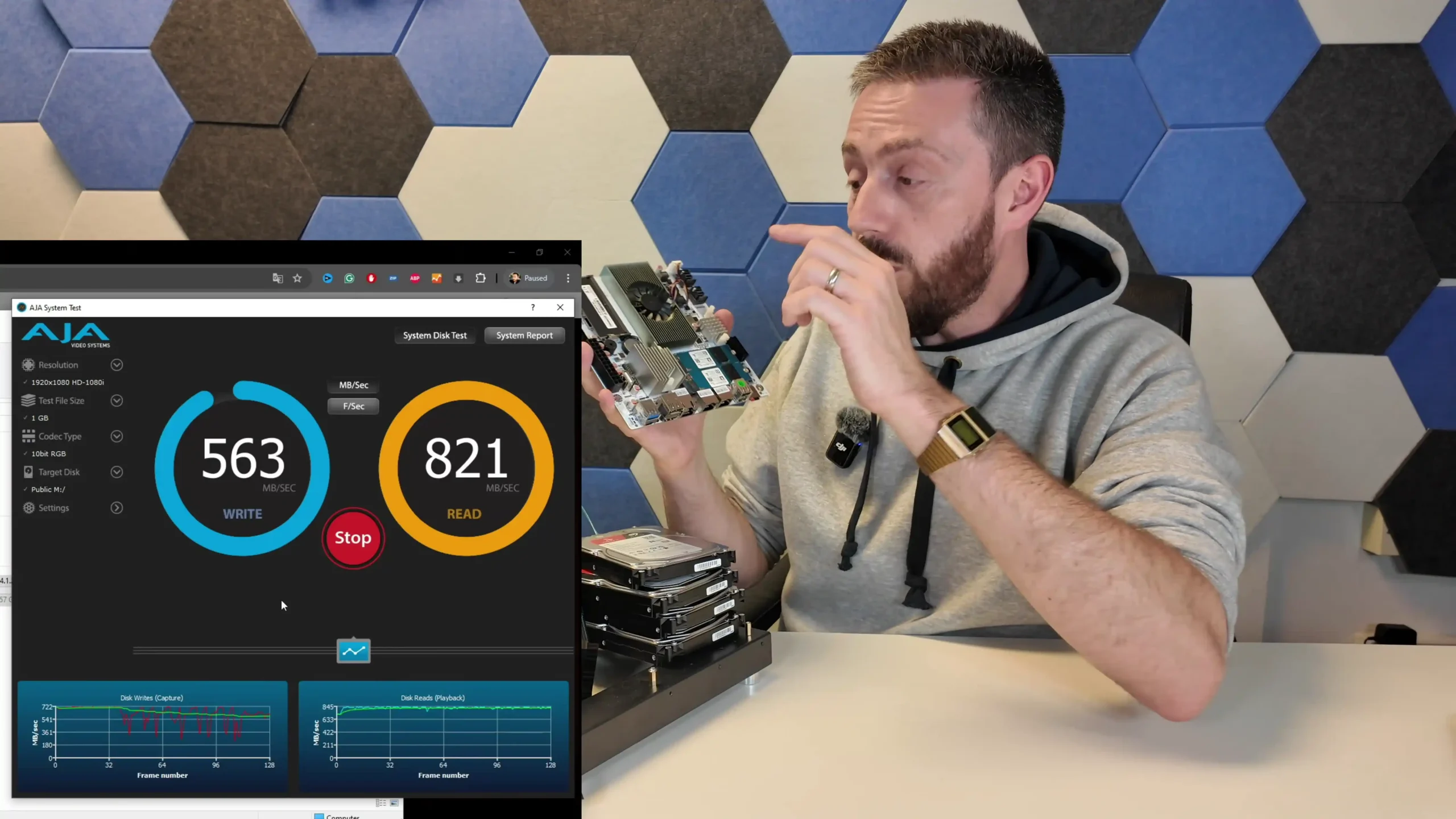
NVMe performance was constrained by the PCIe Gen3 x1 link per M.2 slot, which limited theoretical throughput to under 1GB/s. Tests confirmed read speeds of around 720MB/s and write speeds of approximately 520MB/s in sustained transfers. While not ideal for high-performance VM storage or video editing scratch disks, these speeds are more than adequate for cache duties or container storage. Importantly, the board maintains predictable performance across both NVMe slots, and thermals were manageable under active load without throttling, thanks in part to the pre-attached CPU cooler and accessible airflow pathways on the board’s surface.
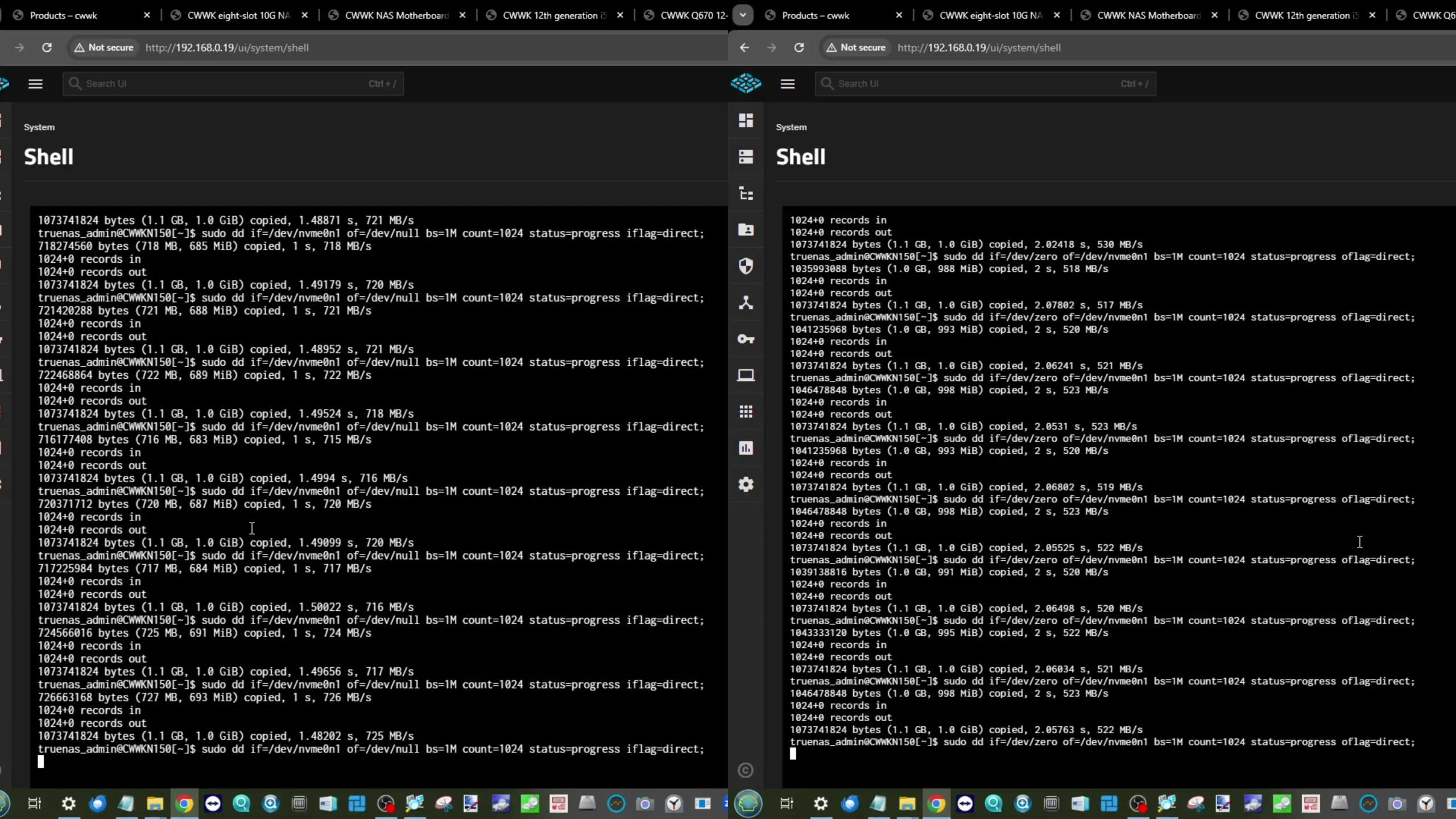
In terms of power efficiency, the system consumed approximately 19–20W under load when configured with the N150 CPU, 8GB of DDR5, two NVMe SSDs, and a 10GbE connection in active use. When idle but fully populated with four SATA drives and an expansion card installed (but unused), power draw settled at around 31.4W. This confirms the board’s suitability for 24/7 operation without requiring high-capacity PSUs or custom thermal management.
 |
 |
| Test Category | Result (N150 Model) |
|---|---|
| 10GbE Read (ATTO, 256MB) | ~950MB/s (near saturation) |
| 10GbE Write (1–4GB) | ~650–700MB/s |
| RAID 1 HDD (SATA) | Write: 550–580MB/s, Read Peak: up to 800MB/s (occasional spikes) |
| NVMe (Gen3 x1) | Read: ~720MB/s, Write: ~520MB/s |
| Power Draw (Load) | ~19–20W (N150, 2× NVMe, 10GbE active) |
| Power Draw (Idle, full config) | ~31.4W (4× HDD, PCIe card, NVMe, no I/O) |
| Thermals | Stable under load; no active throttling observed |
CWWK M8 10GbE NAS Mobo – Verdict and Conclusion
The CWWK M8 motherboard delivers a rare combination of high-speed networking, broad storage expandability, and low power consumption, all within a Mini-ITX footprint. It manages to balance PCIe lane allocation across 10GbE, dual NVMe, and eight SATA drives without compromising basic performance, thanks to deliberate hardware pairing and thoughtful board layout. The use of separate SATA controllers, a well-provisioned 10GbE controller on Gen3 x2 lanes, and native UEFI support reflects a clear intent to make this a serious option for NAS enthusiasts and advanced home users. Its ability to sustain near-saturation speeds on the 10GbE connection and provide usable NVMe throughput makes it a capable base for TrueNAS, Unraid, or Proxmox environments—whether for home backup, Plex media hosting, or light VM workloads.
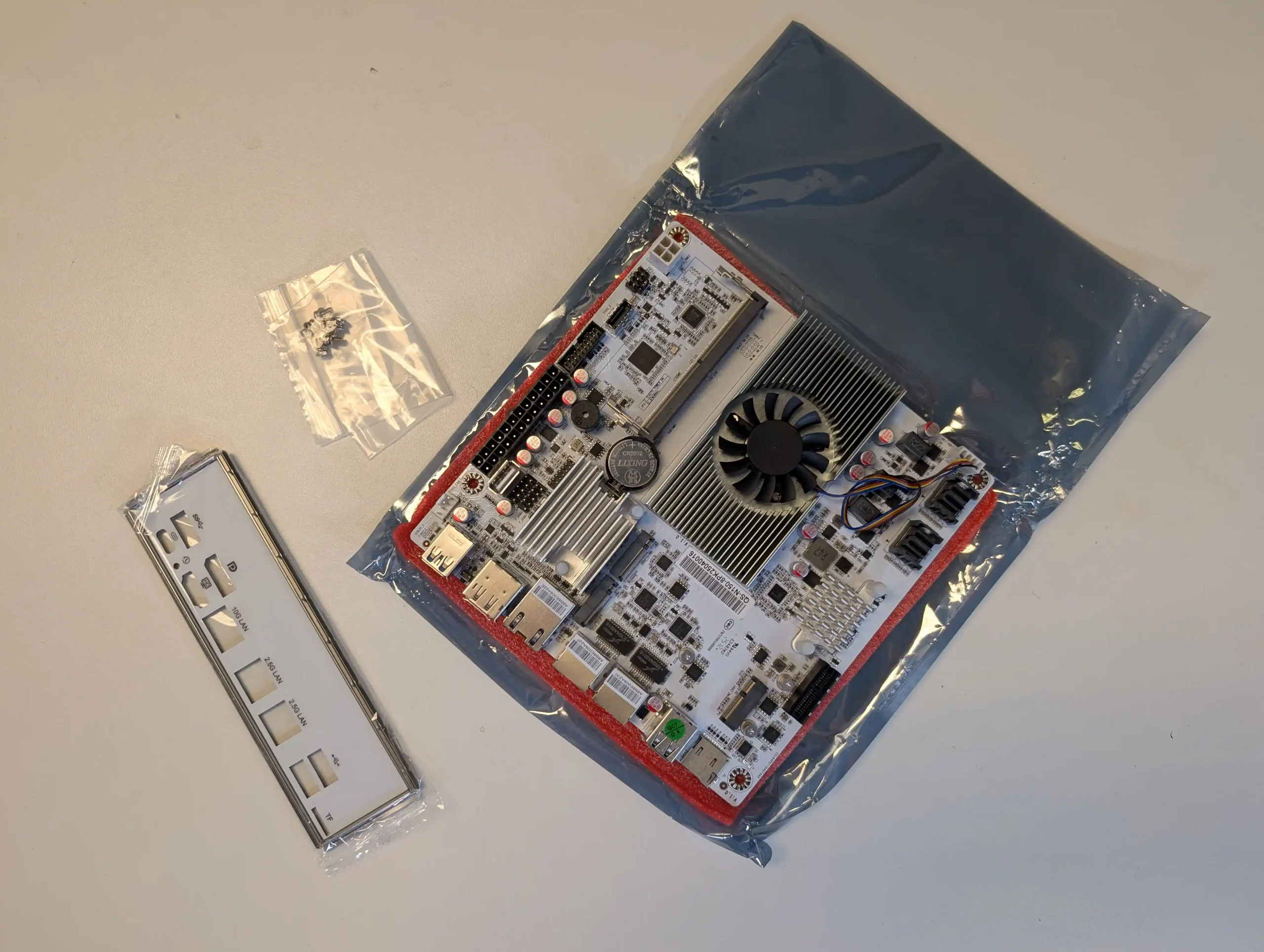
However, there are trade-offs. The limited PCIe expandability, single RAM slot, and Gen3 x1 constraints on NVMe performance may not meet the needs of high-end workstation builders or enterprise deployments. Additionally, the shared PCIe lane between the M.2 E-key and the PCIe slot limits simultaneous use of both interfaces, which could affect those hoping to add both Wi-Fi and a PCIe peripheral. Still, for its price point and target use case, the M8 delivers well above average. It avoids many of the bottlenecks seen in competing low-power boards and manages to do so at under $300 with a pre-installed CPU. For users building a power-efficient, high-bandwidth DIY NAS with flexible drive options and capable base specs, the CWWK M8 stands out as a strong contender.

| Where to Buy? |
| Pros | Cons |
|---|---|
| 10GbE RJ45 port (AQC113C) with full Gen3 x2 bandwidth | PCIe slot and M.2 E-Key share a lane—only one usable at a time |
| Dual 2.5GbE Intel i226-V ports with wide OS compatibility | M.2 NVMe slots limited to PCIe Gen3 x1 speeds |
| Supports up to 8 SATA drives via dual independent SFF-8643 ports | Single DDR5 SO-DIMM slot (no dual-channel support) |
| Includes 2× M.2 NVMe 2280 slots, suitable for cache or boot use | |
| Very low power draw (~20W under load, ~31W idle fully populated) | |
| Compact Mini-ITX form factor with well-organized layout | |
| Pre-installed CPU and active cooling fan included | |
| Broad OS support (TrueNAS, Unraid, PVE, Linux, Windows, etc.) |
🔒 Join Inner Circle
Get an alert every time something gets added to this specific article!
This description contains links to Amazon. These links will take you to some of the products mentioned in today's content. As an Amazon Associate, I earn from qualifying purchases. Visit the NASCompares Deal Finder to find the best place to buy this device in your region, based on Service, Support and Reputation - Just Search for your NAS Drive in the Box Below
Need Advice on Data Storage from an Expert?
Finally, for free advice about your setup, just leave a message in the comments below here at NASCompares.com and we will get back to you. Need Help?
Where possible (and where appropriate) please provide as much information about your requirements, as then I can arrange the best answer and solution to your needs. Do not worry about your e-mail address being required, it will NOT be used in a mailing list and will NOT be used in any way other than to respond to your enquiry.
Need Help?
Where possible (and where appropriate) please provide as much information about your requirements, as then I can arrange the best answer and solution to your needs. Do not worry about your e-mail address being required, it will NOT be used in a mailing list and will NOT be used in any way other than to respond to your enquiry.

|
 |
Minisforum MS-02 Ultra Review
Minisforum N5 NAS, 6 Months Later - Better, Worse, the Same?
Beelink ME Pro NAS Revealed
Best SOLID STORAGE NAS of 2025
Should You Worry About the NanoKVM Hidden Microphone?
Best Cheap NAS of 2025
Access content via Patreon or KO-FI
Discover more from NAS Compares
Subscribe to get the latest posts sent to your email.


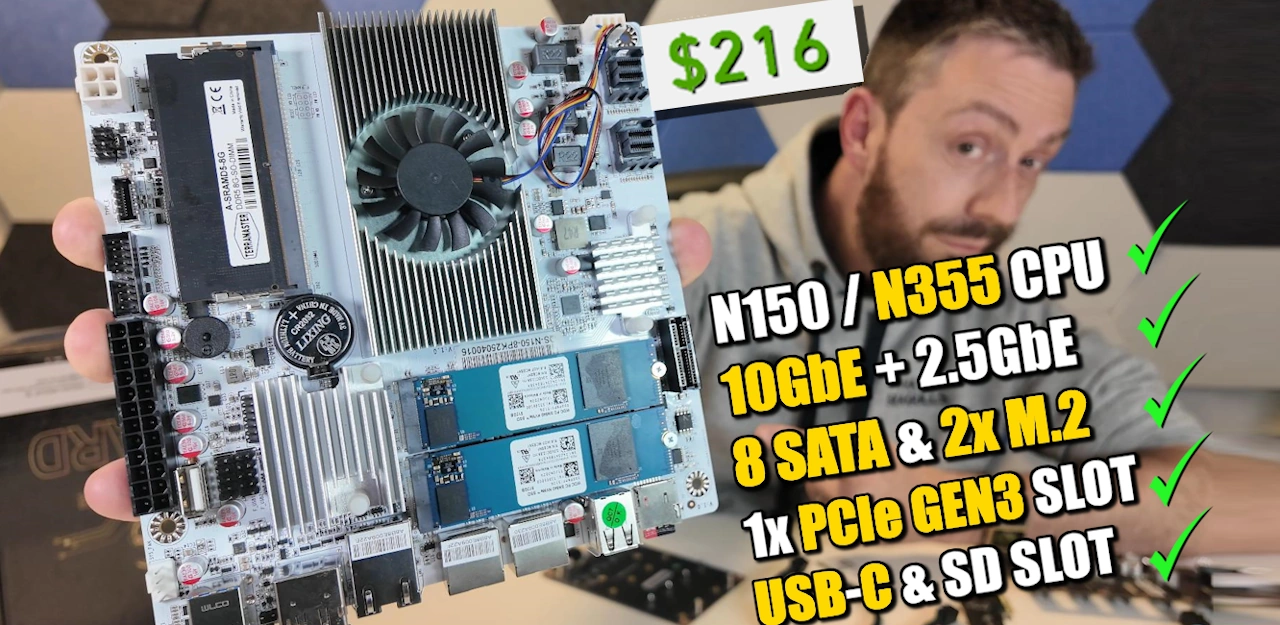
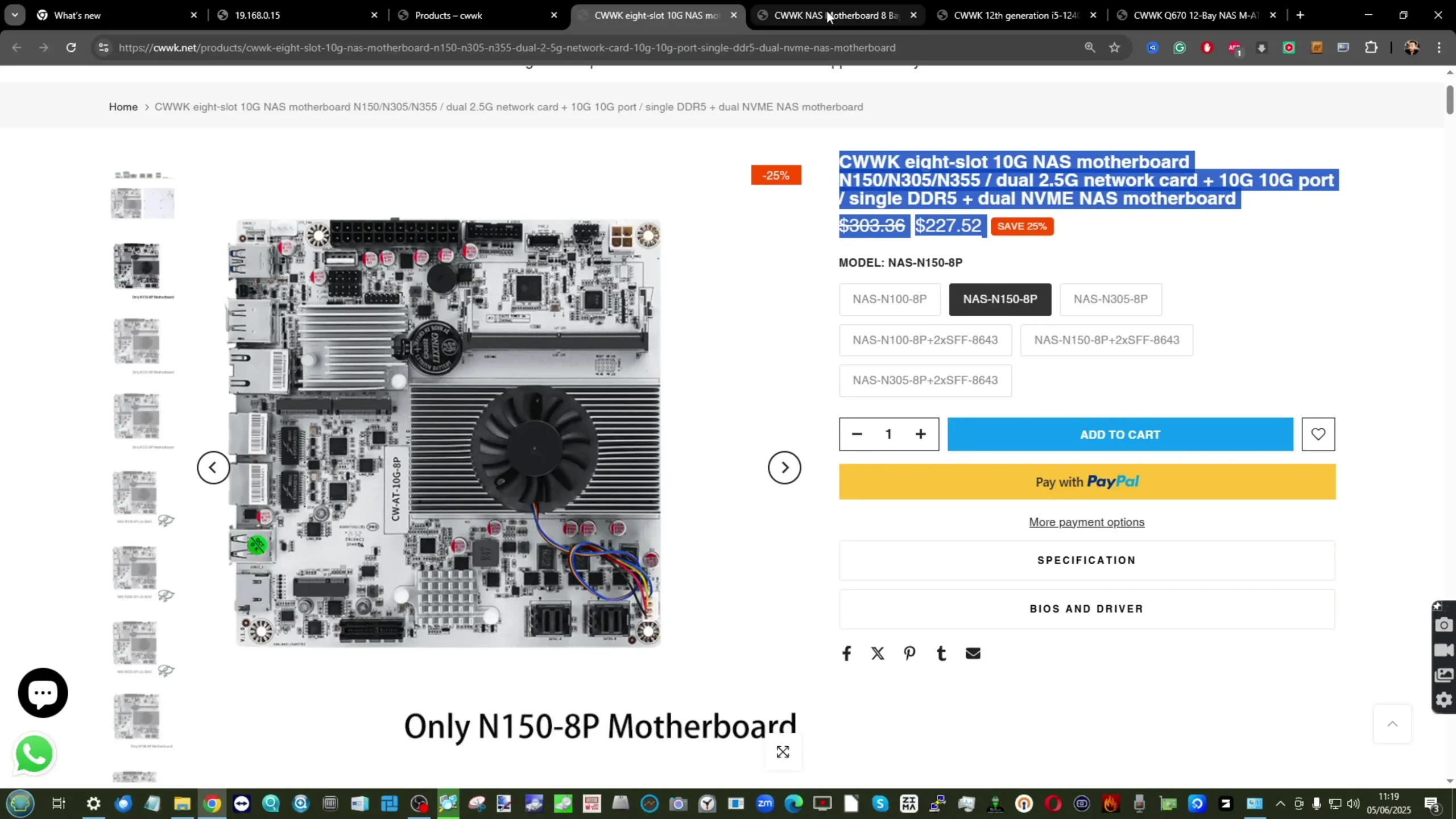



Just skip synology, they can’t be trusted
REPLY ON YOUTUBE
is installing the Synology DSM on a NUC type PC a good solution for a 24/7 small family?
REPLY ON YOUTUBE
I just bought a UGREEN NAS. I like it, but I can’t get my Apple TV to connect to the jellyfish server running on it. I had no problem connecting to JellyFin running on an old HP but I wanted the ease of the UGREEN NAS. but I am about to return it and pursue another option. this may be my route to go.
REPLY ON YOUTUBE
I’ve been building NAS’s since Openfiler back in 2002.. I switched to FreeNAS once it matured enough to trust and never looked back.. Most of my builds were server grade back in the day but these days I have switched up my game a bit.. As of now, for my home lab, I keep it simple with plug and play stuff.. Mini pc’s with 2.5gb and 10gb fiber sfp make for a great tiny NAS base.. Combine these with USB 3.2 C style connected Terramaster enclosures and you’ve got a killer,,,, cheap storage solution..!! At first I was skeptical of these systems saturating the USB bus, which, can happen..!! As long as you don’t go crazy trying to run too many devices you’ll be fine.. I currently have 6 Terramaster 4 bay enclosures with 3 on each of 2 Mini pc’s.. Both these systems have been EXTREMELY stable with zero failures or resilvering for well over a year now..!! I’m impressed..!!
REPLY ON YOUTUBE
You wrote that the IronWolf HDDs were in Raid 1. Raid 1 is a mirror, so write speeds won’t increase, especially not for writes (reads, depending on the controller). I think you meant RAID 0 in that description.
Why does nobody talk about how noisy these soldered-CPU NAS boards really are? The Alder Lake N100 boards from Topton or CWWK come with a terrible built-in cooler, and since the CPU is soldered, you basically can’t replace it. Once you receive it, you’re stuck with a noisy system and no real upgrade options.
REPLY ON YOUTUBE
What about DIY hardware and use XPenology?
I have no experience with that combo, but does that give you the freedom of DIY and the robustness of a solid and an easy to use NAS OS?
REPLY ON YOUTUBE
is there enough space between the slot and the connectors for an x16 card to fit?
REPLY ON YOUTUBE
I still have no regrets backing my 5-bay and 8-bay UGreen NAS’es during its Kickstarter campaign. I got them both at super early bird pricing too! I run them along with my other Synology NAS’es but I actually like my UGreen ones more now as they have improved their OS a lot. For starters, it’s much easier to set up NGINX proxy manager via docker on my UGreen NAS’es than my Synology ones. They’re a lot more powerful too! ????
REPLY ON YOUTUBE
how can when I check the price after each of these videos, the price is double
REPLY ON YOUTUBE
Yes. I just bought all the components for a TrueNAS system.
REPLY ON YOUTUBE
ugreen language translation is not quite there. 02 05 03 01
REPLY ON YOUTUBE
What I also like about this one compared to the Topton N18 is that it actually has proper USB-3 and C headers – so you can actually connect all the front panels of a Jonsbo N2 (or any other Jonsbo NAS case for that matter), without having to buy additional adapters.
REPLY ON YOUTUBE
I went down the DIY route, mainly because I really like playing with PC hardware and building stuff. I went a bit over the top, but the performance is amazing for a home setup. Using Proxmox, with OpenWRT(It’s my router) and TrueNAS as VMs. Mixture of second hand, new and hardware I already had.
AMD Epyc 7k62 48 core
256GB ECC DDR4 3200mt/s (192GB given to TrueNAS)
Asrock Rome D8-2T
2 x 512GB Intel/Adata boot drive
4 x Samsung 970 Pro 1TB (1TB usable, mirrored 3 times as it’s the NAS meta data drive)
12 x Seagate 16TB HDDs (4 x 3 VDEVs)
4 x 10GBe Intel X550 (Star topology for the house)
2 x 2.5GBe Intel I216V (For the broadband)
EVGA 1600w T2 PSU
Phanteks Enthoo Pro 2 Full Tower
Not only is this fast for a NAS, I get 10GB ethernet around my house. It’s not uncommon for me to get 900~1000GB/s over the 10GB network and in Linux VMs doing “local” NAS access I’ve seen sustained read and write speeds up to 1.5GB/s from the mechanical drives.
REPLY ON YOUTUBE
Given the case that I have for my video editing rig I can have 7 3.5″ HDD. With each HDD now having 30tb storage that would equate to over 200tb just for hard drives. I can also have 4 5tb 2.5″ HDD and with a combination of motherboard and 2 add on cards each having 4 M.2 slots that adds up to 10 M.2 with a capacity of 8tb each that adds up to a total of over 300tb storage. From Ethen.
REPLY ON YOUTUBE
Was thinking of DIY but then after reviewing some decided, nope, don’t have time and patience. Thinking of upgrading my current Synology DS418 (before that also had Synology) of switching to UGreen DXP4800 which has strong hardware but middle ground OS/software or the Synology DS425 which has mediocre hardware but strong OS/software. I am more inclined to ease of setup and use across my android mobiles, windows pc and linux notebook, which Synology provides, but then also was wanting strong hardware. Security also matters, especially where AI is local and doesn’t go to internet for its’ computation. Confused.
P.S. Xpenology on DXP4800! Viable?
REPLY ON YOUTUBE
One look at the price for Synology hardware and disk expansion cases, and I went DIY.
REPLY ON YOUTUBE
I have 3 nas. Ugreen 4800 plus, unraid with 10 disks, truenas with 6 ssd. Ugreen is the easiest to use, next unraid, and truenas is the worst in the user interface.
REPLY ON YOUTUBE
4:05 I’m not sure what you mean by the word “intensive” here. It _seems_ that you wanted to imply that CLIs are more complicated and difficult to use, but I think that is disingenuous and misleading.
Command line interfaces should be considered a selling point for novices as well as experienced users since they are invariably more stable than GUIs and much easier to document.
GUIs are better suited to displaying results than as a configuration interface.
REPLY ON YOUTUBE
Team TrueNAS. Got two self-planned and built nodes, with offsite replication and all the bells and whistles. Went full ham on a Supermicro server board with IPMI and AMD EPYC platform for the main NAS. Oh yeah, and cheap 25G fiber aswell.
REPLY ON YOUTUBE
Still cheaper to buy an old pc, add storage and use it as NAS. These pre built systems are very low power and very expensive.
REPLY ON YOUTUBE
Have you tried a 48GB stick of RAM in this board?
REPLY ON YOUTUBE
I have recently purchased the N355 version of this motherboard on Amazon and had to wait about two weeks for the delivery (was sent straight from China). I have had moderate success installing anything meaningful on it, so far. The only thing that has worked flawlessly was either Manjaro or Ubuntu 25.04. I am unable to start the installer for Proxmox 9.0.1, TrueNAS Scale (25.04.2.4 or 25.10.BETA.1) – I got weird graphics errors. The PopOS! Live image was booting from an USB stick (with Ventoy) and at first seemed stable but than crashed when trying to access the disks with a GUI partition tool.
The mainboard sometimes is stuck in an endless reboot loop. Only disconnecting the power for ~10 seconds seems to solve this.
I was looking for a BIOS update but was unable to find anything. There is something official (at least I believe it to be official): https://drive.x86pi.com/BIOS/Intel/2.NAS-Mainboard-BIOS/Twin%20Lake(N150%20N250%20N350%20i3-N355)/CW-NAS-AT-10G-8P The files listed here are from the end of September. But when I copy the ISO file to my Ventoy stick and perform the update the BIOS version reported is from February and the BIOS doesn’t even say the correct identifier for my mainboard anymore (CW-10G-AT-8P I presume).
I was able to get back to the version from 31st of May 2025 by hitting ESC before the EFI boot continued. I was greeted by an EFI shell which I could use to flash the files from one of the ZIP files which I copied to a second USB stick (VFAT formatted).
This is a totally unacceptable situation considering I want to make this my primary NAS. Did anybody make similar experiences or is it smooth sailing for the rest of you? Do you know of an official
Could you do a video on a server for £500?
REPLY ON YOUTUBE
I don’t support Synology and their recent decisions but for someone still looking to buy their first NAS, their software is unrivalled. The dropped drive support is a problem for users that have drives they want to migrate over. Taking away transcoding is just dumb though.
REPLY ON YOUTUBE
I am still running a 12 year old synology 5 bay nas, it’s been running 24/7 for almost the whole time (a few days off here and there when moving house, power cuts, or renovations). It’s got WD physical HDDs in it. The only things I’ve had to do is replace a couple of fans that have got noisy and replace one of the HDDs that failed. The hardware is no longer supported so there has been no software updates for years now. But it just keeps going so I don’t want to spend loads of money replacing something that still does the job I need it to 12 years later. As much as the geek in me would love to build a new nas I can’t justify doing it until the old one breaks ????
REPLY ON YOUTUBE
I am running my own “NAS/Server” for 10+ years… last year Ive switched to Unraid… fk Synology…
REPLY ON YOUTUBE
how is HEXOS now.. IT has been a year since it was reviewed… Anyone has any thoughts here… Time to jump synology..
also has anyone thought about going apple mini and then use it as a NAS? Lot of videos out there for that
REPLY ON YOUTUBE
looking at this video I just can’t help to be distracted by the ugly fingerprint catching shiny mid-2000s-design cheap plastic on the QNAP.
REPLY ON YOUTUBE
I need a stable phone sync app that doesn’t break when syncing a multiple GB sized video or some weird codec. Even QNAP fails there, seems only Synology works. It’s ridiculous really considering phone backup is so important since years.
REPLY ON YOUTUBE
Need a NAS. Know very little about NAS. Need it to be rack mounted. No need for external connection. I wonder if a DIY solution based on something like this would be the way to go, or just buy something like a UNAS Pro 4
REPLY ON YOUTUBE
I went DIY simply because it was cheaper. But It seems like I made the right decision with some of the other locked down things. But now that I have my own, I kinda want the other option as a backup of my backup. Some of those have easier sync options. I wont ever leave the DIY option cause I like the freedom.
REPLY ON YOUTUBE
I bought a CWWK AMD 8845HS motherboard, slapped on a Noctua tower cooler, 32GB RAM, 2x 512GB NVME for a cache pool and just recently dropped in a 20TB Toshiba N300 drive. On this system I run unRAID, within that OS I have multiple VMs and Containers, including a Sophos Firewall VM and a Unifi Network Controller. Basically I have a full home lab all contained within a Fractal Node 304 case. Power draw is a reasonable (80W including my Virgin Media router, a POE switch and a Unifi AP), sound level is low enough that it doesn’t upset the wife, and more importantly it has more than enough processing power to run my full home lab without breaking a sweat. Plex transcoding is handled by the AMD integrated GPU, but I don’t need any transcoding since this is a Direct Play household!
Overall I am grateful to Synology for no longer supporting 3rd party brands because that was the reason I chose not to go for a Synology NAS, and I was only looking at Synology because of SHR. Once that was no longer an option DIY was my only option.
REPLY ON YOUTUBE
Muh se supari nikal ke baat kar re baba……
REPLY ON YOUTUBE
I want affordable DIY cases, specifically Mini ITX or MATX. Why are these so hard to find at reasonable prices?
REPLY ON YOUTUBE
I’m really happy with my Aoostar R1 N150 running ZimaOS. I just had to replace the bottom fan with a Noctua one and put it on felt pads to make it much quieter.
REPLY ON YOUTUBE
Power efficiency is always my thing. I did pick up and old PC with a 6700 but its too heavy on thr wattage, assuming i do leave it on 24 7. I do own a mini PC which is great and pulls max maybe 10ish watts at the wall, usually 7w as it’s idle. I’d definitely go prebuilt, but I’d have to buy something that’s power efficient.
REPLY ON YOUTUBE
I’m still looking for a feature rich, AND easy to deploy and configure, AND cheap or open source NVR. It’s the one thing keeping me from scrapping my Synology.
REPLY ON YOUTUBE
Camp BYO:
Being a Windows/Unix/Linux server admin for the last 30 years, I built my own which is smaller and more powerful than the commercial offerings. First with FreeNAS/TrueNAS, then later with Proxmox and a DIY Linux LXC for NAS duties plus a whole bunch of other LXCs and VMs.
REPLY ON YOUTUBE
My NAS is jast a headless Debian server, because I like pain I guess 😀
Actually it’s because I just liked the idea of learning to manage a “proper” server. I started with Ubuntu Server and made a bit of a mess because I didn’t really know what I was doing, but second time around with Debian it really was a breeze. Now it’s a pretty clean setup with lvm, ZFS, a bunch of smb stuff as well as Plex and Jellyfin (testing before I’m confident enough to drop Plex), both with hardware acceleration for transcoding and tone mapping. Sometimes I even run some game servers.
All in all, very educational, but certainly has quite some learning curve. It also puts you in the danger zone for getting into homelab, now I’m playing around with Proxmox and OPNSense…
REPLY ON YOUTUBE
the only reason i may go for prebuild nas , is the ability to use it from outside my network over the internet , i will use dropbox , since the diy route is to complicate i have try next cloud , don t manage to make it work even truenas dose not support it , don t see any other benifits compar to a simple compute use as nas .
REPLY ON YOUTUBE
Absolutely the time for billionaire’s gold Casio
REPLY ON YOUTUBE
I’ve just built a Nas, which involved rebuilding my old PC back into its old case, and the fun of designing and printing my own harddrive rack with side loading bays. So for the cost of harddrives only (and a bit of 3d printing) I got a Nas that allows me to figure out what I need and how I’m going to use it, and to completey change my mind all I need to do is print something else. Truenas has been easy to set up and use, almost too boring really, I thought it was going to be more of a hobby but I don’t have to do anything ????
REPLY ON YOUTUBE
I’m still using my 10yo QNAP Ts-853 Pro, with added 5G network card. For HDD based NAS (which gives you shitload of storage for pennies) you don’t need anything else.
REPLY ON YOUTUBE
This is exactly what I did. Ditched Synology, bought an Intel NUC with Thunderbolt 3 external drive enclosure. Installed Linux with ZFS, NFS, Samba, JellyFin, etc. So much better than fighting with the restrictive options of Synology.
REPLY ON YOUTUBE
Easy options for someone like myself…… internal network use only… I would (now) choose the DIY route. Internal and external use the now traditional NAS solution would be best. I only use my NAS for internal network streaming, I wish I knew this b4 buying a QNAP solution..DOH ????????
REPLY ON YOUTUBE
I am looking for a nas with N355 and at least 32 giga ram. with low consumption. and 6 bay. i want also to have something safe reagrding data. then not ugreen
REPLY ON YOUTUBE
DIY is always the superior option. If you can do it, you should do it.
REPLY ON YOUTUBE
I really don’t understand “nas OS” as Linux or even windows make good nas and have far more apps.
Truenas is nice way to ease into ZFS, but btrfs keeps getting really good.
REPLY ON YOUTUBE
ditched prebuilt a few years ago now.. I’m never going back.. I was planning to move to synology but that idea died when they moved to amd cpu’s without video codecs in them…and I’m glad I escaped before the whole HD lock-in mess
REPLY ON YOUTUBE
Long time fan, first time commenter!
I’m making the move from my DS923+ (it’s been an absolute kubernetes nfs pvc permissions nightmare) to DIY. I know this isn’t discussed much on the channel, but any suggestions on a DIY setup that works well within a homelab/kubernetes setup? I’m moving my cluster to Talos this weekend and want to plan out the storage swap in the near future. Thanks for an suggestions!
REPLY ON YOUTUBE
I’m still enjoying my 1618+ but i feel that after this unit is unsupported, and in light of Synology’s recent ‘business practices’, I will investigate ‘roll your own’ options, as it were. ????
REPLY ON YOUTUBE
Thanks. I am concerned about reliability. My Lincplus N2 had issues losing some ssds, my Minisforum MS-01 is dead for seemingly no reason. All the while my 2 Synologies are chugging along, one of them for 10 years.
REPLY ON YOUTUBE
I used to think Synology for turnkey… but they don’t care about home/small users anymore, removing apps, codecs etc. (and of course their rip off for memory and the mess with disk compatibility). More and more I’m setting up open source, immich, nextcloud etc in docker as I’m in de-syno mode nowadays. When I get my next nas it sure won’t be Synology. Sorry but I’m not paying a premium for your stuff anymore. And my final, they don’t care, when the f are you going to support dark mode (yes I can use a browser extensions, but its not the point). A proper theme management so I can properly see the current line in file manager etc, uck.
REPLY ON YOUTUBE
It is unfortunate that HP stopped making MicroServers. I have a couple from the G7 era that work great as NAS devices, one running Xpenology and the other OMV. Both have Mellanox Connect-X3 10G add-in cards and run cool and quietly. Somewhat larger than a 4-bay NAS but much smaller than a tower.
For services other than network storage, I run Proxmox on a cluster of 3 1L fanless PCs.
REPLY ON YOUTUBE
Went from turn-key NAS products to DIY and will never go back. I run Plex on my NAS which leverages the GPU to handle transcoding since all my rips are 1:1 and sometimes need conversion. I remember running my huge video library through OCR software to extract subtitles because the low end CPUs in turn-key NAS boxes couldn’t even burn the subs into the video stream without the CPU being overwhelmed. With a DIY NAS you can add a GPU/iGPU to do all the heavy lifting.
I just run ZFS on top of Ubuntu server. If you are not familiar with Linux there isn’t much involved with getting ZFS running on it. The precooked NAS solutions like OMV or TrueNAS are great for new NAS users, especially if you want to run stuff in containers. I didn’t bother with those since I wanted something simple that I’m in complete control of.
REPLY ON YOUTUBE
I love the DIY way. Just received a Minisforum N5 Pro, and I also have one of the new Orico NAS in order for off-site backup. Can’t wait to get it going 😀
REPLY ON YOUTUBE
I went diy 6 months ago. Unraid, 12600k, 32GB, 80TB usable sata storage, 3 nvme zfs cache drives, windows gaming VM, plex server. Blisteringly fast and around 60w standby power consumption. Never going back 🙂
REPLY ON YOUTUBE
I’ve dreamt of doing it, but:
1) It’s not hard to bypass the HDD “lock” on turn-key systems.
2) Yes more OS options, but it’s a steep learning curve, and DIY won’t support those machines if there was a build error.
3) Hardware is getting better for DIY, but they always seem to be a larger case for HDD, and takes more PSU power which is a problem 24/7/365
4) Cost is more than just software! Sure DIY “can” be cheaper, but I’m not sure how much I’d have to save to go DIY. When the DIY doesn’t have a warranty or a customer service chat or phone number to call.
REPLY ON YOUTUBE
Are those AI title card backgrounds? I think I’m done watching this channel.
REPLY ON YOUTUBE
Kraftwerk will be coming for you using their samples! ????
REPLY ON YOUTUBE
I’ve been thinking for quite a while about building my own NAS, especially after Synology basically said ‘screw you’ to their customers. However, energy efficiency and the cost of electricity should, in my opinion, be taken into consideration when calculating the total cost. Whats your take on this and how to calcuate this?
REPLY ON YOUTUBE
Making the plunge into homelab myself and hosting my own apps and files on an NAS due to the availability of nice ITX cases and motherboards that make it very do-able without getting locked-in to a subscription or a Synology-type hardware requirement. I ended up building an 8-bay NAS a few days ago with a Jonsbo N3 case and CWWK Q670 board after various build reviews (including yours).
Some BIOS configuration snafus aside, which I was able to resolve, I have it running Linux Mint for testing purposes to verify all the hardware works. So far so good. Planning on installing TrueNAS Scale and adding 4 28TB Seagate Exos CMR drives when I have everything else configured.
Specs:
Jonsbo N3 case
2x Noctua NF-A9 case fans to replace the original case fans.
CWWK Q670 8-bay Motherboard (revised white version)
Intel Core i3 14100T (may or may not upgrade later)
Noctua NH-L12Sx77 L-Type Low Profile CPU cooler
128GB (2x 64GB) Crucial Pro DDR5 5600 UDIMM Memory
Lenovo Intel X710-DA2 Dual Port 10Gb PCIe Network Adapter Half Height (01DA902) (plus a full height bracket to swap out)
1 x Samsung 990 PRO 1 TB SSD NVMe M.2 (future boot drive – overkill but I got it on sale – I had an ancient 128gb NVMe I was going to press into service but it was not compatible)
2 x Sabrent Rocket 2TB SSD NVMe M2 (for apps pool – pulled from my workstation PC during an upgrade)
For testing purpose I threw in a couple of old SATA drives I had pulled from old systems and they were detected. One has Linux Mint installed as the boot. These will be retired eventually once I get TrueNAS Scale set up.
Planned apps:
Truenas Scale (OS)
Nextcloud
Jellyfin
Possibly Handbrake
Calibre-web
Immich
Possibly Navidrome
As far as Synology goes, I am not keen on any ecosystem (however well-designed) that requires proprietary software. The recent decision to require Synology-certified drives just hardened my stance against them. Nope. They just got added to my sh*t list alongside MIcrosoft, Adobe, Google, and Apple.
REPLY ON YOUTUBE
I bought into Drobo 15 years ago. I had a system problem and lost everything as the array broke down. DIY all the way now.
REPLY ON YOUTUBE
I would be wary of starting something then finding out that I’ve messed up and got incompatible parts. Are there any kit options that come with guidelines?
REPLY ON YOUTUBE
I would build my own if I had time to tinker with it. I love to do that. But for my current needs I just need something I can plug in, add drives and it works. That’s why I have my Synology. I plugged it in 5 years ago and it’s never been shutdown other than for cleaning or updates. Whether I’m at home or in another state it’s there when I need it. Replaces any need for Google or other cloud services.
REPLY ON YOUTUBE
Too much distracting arm waving.
REPLY ON YOUTUBE
personally for a nas, ill stick with a pre built like my ds1522+ is just the ease of use and simplicity.
with my data that a value i have zero interest with tinkering, i want stability and zero risk (its why i dont use linux as a desktop os and only use Windows or macOS, and only linux in a server environment) its why i separate the my hosted services onto a 2 node proxmox cluster on a separate system, in case something goes wrong i dont lose my data in general.
i like the low power and efficiency as well
REPLY ON YOUTUBE
Really fair and valid points raised. It boils down to use case and keeping to what your needs are. I have had some big switches and an old blade but they were loud and power hungry. Now I have two pc, 4790k 32gb ram and 7700k 16gb ram, with an array of nvme , sata SSD and HDD. its perfect for me, its quieter, uses less power, smaller foot print, flexible, easy to get parts and upgrade over time. that is what I wanted. Turn Key and going bigger DIY had to big an outlay cost for me, I don’t think negatively of the turnkey stuff due to nice simple layouts and all in one construction. I just love tinkering. I have been really having fun with CasaOS, proxmox etc.
REPLY ON YOUTUBE
What about families in the Apple ecosystem? Do you recommend using a Mac mini? It’s energy efficient, and even has a new native containerization framework. For docker like functions.
You won’t have the build your own joy but it could be a nice way to go?
REPLY ON YOUTUBE
The only thing stopping me from moving (apart from the money already invested in Synology 4 bay + 5 bay expansion box!) is Active Backup for Business – if I could find an alternative solution (that was as easy to use, solid and natively supported Windows & Linux) I would likely move. Really don’t like the way Synology have gone with ever increasing lock in …. 🙁
REPLY ON YOUTUBE
When I was younger I built my own pc for gaming and had a lot of fun tinkering. For a NAS I would rather buy something purpose built whilst accepting that it wouldn’t be as full featured / powerful as DIY.
REPLY ON YOUTUBE
I’m very happy with my 2 drive ugreen. I usually like to diy things but the ugreen solution was exactly what i need.
REPLY ON YOUTUBE
My RAID5 QNAP died with a hardware failure, and now my data is stranded, forcing me to buy another QNAP to rescue my data. I will, and then move to a mdadm that I control.
REPLY ON YOUTUBE
I believe most people don’t really need a 24/7 available nas
REPLY ON YOUTUBE
Try to change trays on ugreen not just every video, but after every b-roll
REPLY ON YOUTUBE
Nope, I just bought a Ugreen – I will never by Synology though
REPLY ON YOUTUBE
Thank you for doing this but you only focus on hardware. What about software? Features? Could you do that? All the backup apps, mail server, file server, Drive Sync, document link sharing, etc … I’m on Synology. Pretty happy with it. Curious on what’s on the other side.
REPLY ON YOUTUBE
I need to know where 04 is!!
REPLY ON YOUTUBE
Yep, as stated the other I tossed my old Synology and built a DIY. Screw proprietary software!
REPLY ON YOUTUBE
My friend, I agree. Zima OS Nas software it’s amazing!, and I have three of them brands Qnap, Synology and Asustor.????
But thanks to Nas Compare???????? I have installed Zima OS 1.44.1
I have it installed on the Beelink Me, and on a PowerEdge r440, they both run flawless.
And the remote access function is awesome???? on the R440, which I have in production. Which I have lockdown for my UniFi network.
Thank you again, Nas Compare????
This video is Top Notch????????????????????????????????
REPLY ON YOUTUBE
That Kraftwerk clip ????????????
REPLY ON YOUTUBE
Cough, cough, never expose your NAS to the world directly… OK go ahead make your day!
REPLY ON YOUTUBE
open-media-vault is the most underated NAS OS BAR non. Unraid is great, TrueNAS/FreeNAS are good but you need to know SMB commands to make it easy to use. OMV is just the perfect sweetspot and even better if you have a cheap Adaptec RAID card to manage your drives.
REPLY ON YOUTUBE
Which NAS OS has flexible drive capacity raid like Synology’s SHR?
REPLY ON YOUTUBE
@NASCOMPARES – What does this mean for ECC NAS RAM ?
Gigabyte’s AI Top CXL R5X4 quietly expands RAM capacity for demanding workstation workloads
The card supports four DDR5 RDIMM ECC modules totaling 512GB of memory
PCIe 5.0 x16 connection ensures direct CPU access for improved performance
REPLY ON YOUTUBE
I am currently parting out stuff for a DIY NAS right now. Rack and UPS included.
REPLY ON YOUTUBE
I built a DIY NAS on a Pi using OMV and a USB drive to solve a short term network file sharing problem one time. Built in short order from bits lying about on the desk, it saved a bunch of passing the shared drive around the various devices on the network. FrankenNAS performance was pretty good actually but not any sort of long term production solution. Hand made is good option for folks who want to mess about and build the thing that matches their vision.
Off the shelf though, generally smaller form factor than hand made, low noise, low power consumption, built for the job, no messing about. Could be pros or cons depending on personal perspective.
REPLY ON YOUTUBE
The problem with turn key solution is once you buy it kind of stuck with it. It may last 5-10 years, but after a while you will have to buy another one. At this point you outgrowing your current setup. With DIY, you can start with modest hardware . Reuse older components and concentrate on acquiring hard drives at your own pace. Eventually, after couple years, the same hard drives can be transferred to a new hardware. I think Synology is preventing it currently on their new hardware.
REPLY ON YOUTUBE
As someeone somewhere between a pro-sumer and homelab-er, I’m willing to take a bit of perf hit for polish and stability… but Synology sure has been testing me on the compromises.
REPLY ON YOUTUBE
I still looking a stupid simple NAS, where I can just plug my disks of different sizes and the data is like 99.9999% safe.
REPLY ON YOUTUBE
Why are u smirking about Charlie Kirk being shot in the neck.
REPLY ON YOUTUBE
The Fuck you mean OMV fell off?
REPLY ON YOUTUBE
I’ve purchased 2 QNAP 8 bay desktop NAS systems. The hardware (CPU/memory) is underpowered from the start and they have very limited RAM capacity/expandability. But what has really annoyed me is that the major OS version updates have not been supported on my systems. I would have liked to build my own, but I am not satisfied with the variety of desktop 8 or 10 bay 3.5″ cases. I backed the Orico Cyberdata kickstarter and plan to test various software platforms.
REPLY ON YOUTUBE
Turnkey are appealing, but I wonder how much fine tuning you can do with the apps when you want the NAS to be your all purpose server (Web server, IMAP server, Home Assistant with Zigbee dongle, File server) ? Apps may also be available in containers, are they fat and does they slow down the system ?
REPLY ON YOUTUBE
For more compact NAS cases!!
REPLY ON YOUTUBE
I got a problem on my “DIY side”: can´t decide between Xpenology and Truenas. I´m using Synology Hardware for a long time and I´ll use my DS1621+ as long as it is supported. But for sure I won´t buy any new Synology hardware unless they drop their restrictions.
For fun and additional roles I´m also using some Xpenology Systems for a long time, which are running pretty well I must admit. But now I tried a Truenas build and I´m amazed how well Truenas runs. Especially setting up Jellyfin and Immich is way more easy than on Synology. I´ll guess I have to run both and maybe get additional hardware. ????
REPLY ON YOUTUBE
For roommate approval factor (5G internet with best signal in the living room), the Ugreen DXP2800 was a pretty compelling solution. Discreet enough to stick next to the AP without drawing attention.
REPLY ON YOUTUBE
You always post the most interesting topics in your channel, keep up the good work. I’ll stick with DIY, more power, more slots, less money spent, and above all, better power consumption.
REPLY ON YOUTUBE
I Ditch Synology for UGREEN 6 months ago. Never looked back ????
REPLY ON YOUTUBE
I don’t understand your argument regarding support. Community support is often way better and faster than corporate support (except for warranty issues)
REPLY ON YOUTUBE
Going DIY right now. Looked long and hard at Synology, Qnap, Asustor. Even bought one, but returned it. It takes a while to collect all the parts but you get much bang for your buck if you shop around and compare going DIY. I get Xeon, hundreds of gigs of ECC memory all for a fraction of what a turnkey solution cost.
REPLY ON YOUTUBE
no more synology for me. I’ve said that before, and I still mean it. I also refuse to watch videos touting synology anymore (including nascompares)
REPLY ON YOUTUBE
Support in turn key NAS is not always the best. For example I tied to do 1:1 copy from old DS1819+ to DS1525+ with no success at all. After 10 days of writing to support and reading how they blamed everything else but not Synology I gave up. I would rather invest time to learn something new with DIY NAS than wait for the crazy answers in support ticket. Restoring task speed 10MB/s on 2000 EUR NAS is no way neither the CPU V1500B with end of life 2028. I wanted to call Synology support but that one engineer who is responsible for 15 mil Czech and Slovak just did not have a time.
REPLY ON YOUTUBE
What options do you have with a turnkey system when the manufacturer decides it is EOL and there will be no more security updates for it? Will you be able to install another OS on it or not? I still have a Netgear RN316 that had some Debian flavor on it and the support stopped with Debian 8.11. Also they made it very hard (no documentation on it at all) to install another OS on it. The system still works fine, but the software is really old. For any turnkey system I would recommend only those that give you an option to install another OS after they go EOL, which they inevitably will at some time.
REPLY ON YOUTUBE
I’ve never owned a turn-key home NAS. About 10 years ago I picked up a Supermicro X9 montherboard, an HBA, an 8-bay hot-swap case, and installed FreeNAS. I started with 3 TB SATA drives but now I’m using 22 TB SAS drives. I have had one motherboard die, but other than that I’ve had no issues with this system. I see no reason to pay a premium to use a turnkey NAS.
REPLY ON YOUTUBE
I hope now is the time since I am half way through building my own.
REPLY ON YOUTUBE
My MicroCeph cluster has two QNap devices running ubuntu. It works, but they’re not the fastest of nodes.
REPLY ON YOUTUBE
I tried a QNAP 4 bay nas a few years ago – compact, easy to setup, nice selection of utilities etc but not that cheap. It started playing up at about 2 years old. 2 bays stopped working, fan was on max and temp readings were all wrong. Believed to be an issue with the intel cpu they used that fail over time. Of course everything was attached to the board so no means of replacing components. 🙁
So went for a mATX intel based board and a 4 core 8 series intel cpu, nothing fancy but has 6 sata connections. Setup in a small cube case with 6 drives and using freenas/truenas and has been working fine for years. Got a couple of external drives I do backups too, just in case. Using WD Red NAS drives, which I’ve had one fail (or at least starting giving smart errors). May look to change to bigger drives or SSDs when prices are a bit better.
REPLY ON YOUTUBE
No thank you, I don’t have time or energy for that, I prefer a Synology.
REPLY ON YOUTUBE
Yup! Self built, still going strong, i’ll never go back to turnkey solutions.
REPLY ON YOUTUBE
Been waiting for a 12+ bay case (hot swappable) that is descent price. Not in love with Jonsbo N5 honestly but might end up going with that if there is not one available soon. I’m coming off of a Synology system because i have lost faith in synology.
REPLY ON YOUTUBE
For Apple fans, there’s also the hybrid option between DIY and turnkey: use an old Mac mini (eg M1 refurb or 2nd hand) with an external drive enclosure (JBOD or RAID for example). MacOS works fine as a server OS for backups, media libraries etc.
REPLY ON YOUTUBE
NAS-devices were correctly priced at the start of -00’s. Then they abandoned EU customers and priced themselves for Americans, Middle-East gulf oil countries and new rich chinese. So fuck’em i say. Never a NAS, never a new PC 2025->.
There are other hobbies one can have that are free.
REPLY ON YOUTUBE
Intel CC150+ 32 Gb ram+sata ssd with openmediavault+ 10g intel+ 2x2tb nvme + 4tb Hdd =30 watts , .more than happy 🙂
REPLY ON YOUTUBE
I keep thinking, if only Truenas would get fleshed out more to compete with turnkey OS’s. The solid ZFS basics are there but… Also I’m not a CLI-warrior. Kudos to those that are, but don’t expect it if every user to be one.
REPLY ON YOUTUBE
I heard the Sultan of Brunei runs a WTR MAX AMD R7 PRO.
REPLY ON YOUTUBE
It is always time to DIY????
REPLY ON YOUTUBE
Hello, I really like your videos and the infromation you provide.
Will you one day make a build of a complete DIY or something like ? OR at least not only show the motherboards, but all other hardware required ? (alimentation, cases ? etc )
REPLY ON YOUTUBE
Start turnkey, migrate to DIY if you feel like you want more.
REPLY ON YOUTUBE
Turnkey is convenient, but has an ongoing cost of having to replace the unit when either the software and/or hardware inevitably goes EOL (assuming you want the latest bug fixes and security patches). DIY can largely eliminate this, but has an ongoing cost of your time and skills. After experiencing my first NAS (WD MyCloud EX2) going EOL, I’m firmly in camp DIY going forward.
REPLY ON YOUTUBE
LOL – I gave up on my DIY disasters and bought a UNAS Pro on Sunday. Of the 8 incidents I’ve had 1 has been actual hardware failure, the other 7 have been some unrecoverable OS management oddity. DONE.
REPLY ON YOUTUBE
Why bother with any NAS OS? Just run any flavor of Linux you like and configure any services you want. The stupid GUIs can all go to hell!
REPLY ON YOUTUBE
Regarding NAS cases: these are not necessarily cheap. Considering today’s drives (up to 30 TB), is not a regular case with 3 drives slots good enough?
REPLY ON YOUTUBE
I’m just building my Jonsbo N2 NAC. That is NAC as Network Attached Computer. Figured out I also need some extra processing cores at the same time when I need larger storage, so R9 5950x with ecc and running Win 11 with a software Stable Bit. Anyone tried this software?
REPLY ON YOUTUBE
For me, Hyperbackup is the killer app. Is there something similar on truenas or any other alternative?
REPLY ON YOUTUBE
I use mdadm and Samba with smb.conf edited using vi, running over Debian.
Can this be considered a NAS software or is this enough to qualify me as a dinosaure? ????
REPLY ON YOUTUBE
Where is the AOOSTAR WTR MAX ?? Any issues with that?
@nascompares
REPLY ON YOUTUBE
It all comes down to one thing for me! Unraid allows you to use different sized and mismatched drives in your Arrays (Pools). Hard drives are the most expensive part of any NAS so it only makes sense to go the route that gives you the most flexibility when it comes to your hard drives. So for me it has to be either a DIY Nas or some kind of a pre-built that will allow you to use Unraid!
REPLY ON YOUTUBE
NAS is a bit of a misnomer these days. What you are buying is a small server. The only real difference between rolling your own and a turnkey solution is the amount of hand holding that you get and the fact that in a turnkey solution the hardware/software/config has been validated to be reliable.
REPLY ON YOUTUBE
Been using local LLMs (AI) to manage data, networking, etc. DIY seems the way to go on that route.
REPLY ON YOUTUBE
Whatever the choice, you should ditch synology proprietary HDD.
REPLY ON YOUTUBE
This is exactly what I did about six months ago. Dumped the contentss of my Synolgoy NAS to a 2TB drive. Then turned it off and put it away. I did pull the disks but used new ones first to set up my new NAS which is a Proxmox box running on a x570 mobo. It runs TrueNAS Scale just fine. Once I loaded the data back I then created a 2nd VDEV of the same size and disks as the first. I also run a bunch of other stuff from this Proxmox server and it runs well. I didn’t like the direction Synology was heading. I have had no problems with them over the years of having two NAS systems from them. They even replaced the mobo on my first as it somehow died. But I like the control I have now and would not go back.
REPLY ON YOUTUBE
Terra-Master is anything but locked in, IMHO. It’s not the highest quality casing, but it’s a standard PC and they run Unraid just fine, even within warranty. With Unraid you get a working real-time RAID system built on top of standard file systems and, if you stay away from their own Docker implementation and run Portainer as your Docker manager you’ve got compact, decent hardware and freedom in terms of your containers and your data.
I’m not arguing against BYO, just saying it’s hard to get something as compact, as power-lean and as “acceptable by your partner” as a small Terra-Master box.
REPLY ON YOUTUBE
What is the trajectory? We have several open source Nas operating systems, and we are seeing more hardware platforms that allow installing those open source solutions.
REPLY ON YOUTUBE
Whereas I can image that turnkey is appealing, if you really want control over how and where you store your data, BYO is the way to go. And honestly, if you can install Windows, you can install TrueNAS. It’s not really rocketscience.
Putting the hardware together can be a challenge but there are plenty of tutorials online. If you are not afraid to dive in, I bet you are done with the hardware part within an hour and move on to the software part.
Also, a lot of those turnkey appliances are chonically underpowered in terms of CPU performance. With BYO YOU can decide what you put in. Do you want to run containers? Aim a bit higher with your hardware. And regarding apps, look at the apps section from TrueNAS. It will get you quite far.
So, I come to a different conclusion; unless you really do not want to spend time on the hardware part and just want the ‘service’ as quick as possible, go with the of-the-shelf brands. But if you value where you invest your money and you are not afraid to get your hands a little dirty, build-your-own is the way to go nowadays.
REPLY ON YOUTUBE
i just bought Jonsbo NAS Case for less than $400. and it can hold 12 drives HDD and 4 SSD. to me this is amazing so i jumped ship.
REPLY ON YOUTUBE
Having the option for turnkey or DIY nowadays is just neat in general as you didn’t have much options a decade ago
Also I kept hearing turkey solution so I got hungry ????
REPLY ON YOUTUBE
The issue would be you can’t get free m365/gws backup anywhere else. I still think if Synology enters the space they will beat Synology if they include those licenses and they already beat them on hardware and entry level sufficiency
REPLY ON YOUTUBE
In the past I’ve built like really big storage systems as my job, based on Nexenta Solaris ZFS running on Dell hardware.
Yet, at home is it different, one of the main reasons I’m using Synology (DS1621+, DS916+ and dedicated NVA 1622) is that power usage is so much lower compared to DIY.
Maybe one day I might just be building me a nice Truenas system.
REPLY ON YOUTUBE
If you are not familiar with DIY, or don’t want to dive into the rabbit hole, it’s OK to buy a pre-build NAS and install the OS your want.
If you want to DIY NAS, just one suggestion, don’t think too much on how to build my NAS, just think it like DIY a basic PC, then consider what you you need, like how many disk, how powerful it would be, you don’t have to use a special case or ITX mobo.
REPLY ON YOUTUBE
Wow that’s unexpected. You set up 2″5″31 now lol
REPLY ON YOUTUBE
For me I prefer to build because I get exactly what I want from a performance perspective. But for friends I’ve been recommending Terramaster and then I help them setup unRAID on it. That means all the difficult parts are done and I can even help them remotely using screen sharing for the software configuration.
And my friends (I’ve helped 2 now do the terramaster thing) like two things about these systems, they have a lot of slots (both bought 12-bay units), they’re affordable when it comes to the price per slot and they get an Intel chip to do Plex transcoding. I don’t have any attachment to Terramaster as a brand I just think right now they have good options. If some of these other NAS brands decided to let you boot whatever OS you want and added more slots at a reasonable price I’d recommend them too.
REPLY ON YOUTUBE
kraftwerk is always a great choice!
REPLY ON YOUTUBE
I’m in the pre-built NAS camp. I’m currently running a six and a half year old QNAP TS-1277 with six 10TB NAS drives in it along with four 500GB 2.5″ SSD’s that I use for my Plex and Channels DVR systems, and for sharing data and backing up the desktops and laptops on my home network.
Prior to getting the TS-1277, I tried the DIY route, but kept coming up with hardware compatibility issues with the OS, and the lack of a user friendly OS that didn’t require a lot of babysitting, caused ne to look at QNAP. What I like about QNAP is I go into the OS once or twice a month to check on updates, and the system notifies me of problems.
That leads me to today. In the past few months, I’ve had two of the six 10TB drives start to fail so I decided to do an upgrade to my NAS. I looked at DYI again, but decided to bite the bullet and stay with QNAP. For this system, I wanted to go all solid state in an effort to reduce some of the heat and noise the TS-1277 produces. When the TS-h1277afx, with all of the new SSD’s installed in it is fired up, you can barely hear it.
I recently purchased the QNAP TS-h1277 which can handle twelve 2.5″ SSD’s. Because I have almost 20TB of data on the current NAS, I’ve installed twelve 4TB 2.5″ SSD’s in the unit. When is ordered the drives, I ordered three drives at a time and different times in hopes of getting drives from different manufacturing batches. Also ordered a 10GB network adapter to install in the old TS-1277 so I can connect it to a 10G switch that that is on my network. Both NAS devices will connect to the 10G switch and will help speed up the transfer of the data and settings from the old NAS to the new NAS using QNAP’s HBS 3 app.
Currently prepping both NAS devices so once I receive the new network adapter (UPS is taking it on a tour of the US), I’ll start the transfer process.
REPLY ON YOUTUBE
The challenge of DIY NAS please help with is motherboards have a variety of pcie channels with different but similar connectors? The advantage is huge that I can start at any size and add in any way, using everything from m.2 to ssd to large capacity hard drives. Can use a small case I already have and just get a bigger one or jbod for big drives or mini m.2 setup. But channels??? A 25 years old atx case with dust still fits atx boards off ebay or new and holds tons of drives. Turnkey obsolescence – Ifw have 5 hot swap hard drives and want to replace with SSDs =junk.
REPLY ON YOUTUBE
Also I have to say that most DIY are more power hungry than turnkey and this is important in places where electricity is not cheap.
REPLY ON YOUTUBE
I have been utilizing an Asustor at my company for years. As our data volume increased, the EZ Sync just ended up not being able to operate properly, some computers would sync, some would not, remote sync became sporadic. I recently built a self-NAS solution using an Intel NUC we had laying around, with a Sabrent 5 bay docking station. Using ZFS Raid and 5 2TB Barracudas, loaded the NUC with Proxmox, installed Nextcloud, and setup a clouflare tunnel to the unit. We couldnt be happier. Once we have 3 months under our belt without any issues, I am going to basically convert our Asustor unit to this setup as well and utilize it as a remote backup to our new setup. We didnt really use any apps on the Asustor, but if we ever want to, we can just install an instance of TrueNAS or something similar. The whole Proxmox approach is incredible for our application, and find myself researching new ideas i have for other environments to add to the proxmox setup.
REPLY ON YOUTUBE
If you love Synology and want to go the DIY route you could look at xpenology which allows you to run DSM on any hardware you like
REPLY ON YOUTUBE
time for ugreen nas
REPLY ON YOUTUBE
Recently built a DIY NAS with the Minisforum BD795iSE, a 16i HBA, and a Jonsbo N5. Going strong with unraid.
REPLY ON YOUTUBE
My concern is getting a case that doesn’t suck (e.g. Too cramped, poor airflow, flex PSUS) and that doesn’t take too much space.
Then there is the psychological perception of a small cube being a NAS vs a mini tower being a server… ????
REPLY ON YOUTUBE
I love to see a pcpartpicker style comparison between a DIY NAS and turnkey. I wonder if, beyond 4 bays, the % difference in savings makes DIY less appealing. For instance, an 8 bay system with a i3 or i5 with 20 or 24 TB HDDs. The savings in terms of money might only be like .. 2 to 5%
REPLY ON YOUTUBE
Never bought a NAS, always to expensive and pretty slow internals.
I run OMV on a DIY JBOD NAS, just setting up a backup server with an external USB, on bare debian, but not everyone has the knowledge.
Now there are so many opensource and free os’s, for the home user DIY is the way to go.
REPLY ON YOUTUBE
So Terramaster gave absolutely NO response to security incidents aside from “we’ll look into it”, and that was months ago. Yes, it’s time to build your own NAS, or at least, get one you can install your own OS on instead of their stuff.
REPLY ON YOUTUBE
I’d love to build my own NAS in the interest of re-using old equipment to reduce e-waste (and because I loathe overpriced proprietary systems), but sadly, there is a dearth of good case options, especially for m-atx.
REPLY ON YOUTUBE
I get the attraction of DIY but nowadays I just don’t want to spend the time needed to investigate the right hardware and software, collecting it, setting it up and maintaining it. It is always going to take more time and I no longer want to spend that time if I don’t have to.
REPLY ON YOUTUBE
Synology Drive client and Synology Active Backup for Business are the only reasons I’m sticking to Synology in my home solution. Otherwise I would have moved to home brew already.
REPLY ON YOUTUBE
Most of the turnkey NAS es are underpowered and overpriced to begin with. You are paying mostly for the support and software which with few exceptions(Qnap and Synology which granted had a long time to polish it)) still feels like a beta version. on pretty much all the new players (Terramaster, UGreen etc) For most people are ok but still overpriced and like you said you are very limited in terms of upgrade and expansions. The options for DYI are now now far more than they were years back. If you add to that the OSes that keep on popping up I don’t see any reason why a person with decent PC building skills wouldn’t build a NAS.Or just ask your more savvy friend to build and install the OS. But also like you said the learning curve deters people to go this way but on the long run the skills acquired in the process will be very useful. But to each his own, some look at this and think it’s some sort of sorcery for which they do not have the patience nor the knowledge to tackle and prefer to buy a prebuilt solution, some are more technically inclined and would love to tinker with the hardware and the software. Now we have a lot of options for sure ????
REPLY ON YOUTUBE
I am ditching my synology platform because of the locked in hard drive. I have a U3, 3d printed case with hot swapping hard drive bays. I have 10gig and 1 gig internet ports. I am currently making a clone of my system to place at another location so I can have a safe backup.
REPLY ON YOUTUBE
Hahaha, got you… Kraftwerk we are the robots.
Awesome video, thanks. Our office has an older computer that will be turned into a NAS after the new one arrives. Your video his helpful for us to choose its system.
REPLY ON YOUTUBE
Thanks!
REPLY ON YOUTUBE
Camp Turnkey:
1.) I start things, but tend not to finish all of them.
2.) I
REPLY ON YOUTUBE
If anyone has a link or suggestion on building a quite 1U Plex server with hardware transcoding I would love to hear from you.
REPLY ON YOUTUBE
How many cores should i be looking at when building one? Please recommend some CPUs
REPLY ON YOUTUBE
Though I think it might be fun to build a DIY NAS, it seems like most of the cases are huge when compared to Synology, Ugreen, and others in the turnkey category. I like the idea of buying from Ugreen or Minisforum because you get the ability to install the OS of your choice, but still get a hardware platform that doesn’t make you feel like you’re using a full-blown PC as your NAS.
REPLY ON YOUTUBE
The general advice I have is: are you suggesting a build to a family member or a business? Then go turnkey every time. Remember, if you build it and they break it, guess what, you’re on the hook for fixing it. It’s much better for your own sanity and reputation if you can hand over a problem to a vendor who knows their product stack really well.
If it’s for yourself, consider if you like spending your weekend away somewhere or troubleshooting an issue. If it’s the latter, then DIY is for you. In the world of DIY, there’s probably very few who have the exact same configuration as you for the motherboard, cpu, memory, SSD/HDD, OS, containers, app versions, or who followed the same guide online to set up your services.
REPLY ON YOUTUBE
I just love the door selection on the Ugreen 4 bay. 2, 5, 3, 1. The man has a sense of humor!
REPLY ON YOUTUBE
These proprietary systems are so expensive and lack the flexibility, so I bought a secondhand Hp elitedesk, stuck a Nvme and 2 hard drives in it and added ZimaOS and Jellyfin, never done it before, a couple of hiccups but ZimaOS was so simple and Jellyfin gives me a basic system to load up my dvd discs. Happy days.
REPLY ON YOUTUBE
There is no right or wrong answer. It all depends on the person, what they want to deal with, and their usage situation. As are so many things.
REPLY ON YOUTUBE
Trolling so hard you found a 05 tray on a 4-bay NAS. I think HexOS is mostly selling itself on future promises, mostly buddy backups. I think the only reason anyone pays $200 now is cause they don’t want to pay $300 when it’s actually ready.
REPLY ON YOUTUBE
I started cheap building my first NAS myself while learning to homelab… then I outgrew this and wanted a second NAS for backing up the first one, but needed something efficient, so I got a Ugreen 4800 plus during their kickstart. Can’t be happier (after I installed TrueNAS, ofc)
REPLY ON YOUTUBE
I got my ugreen dxp 8800 plus it’s my first nas and I got to thank you for this. Your video gave me alot of confidence sinking this much money and I love it every single bit. Overkill yea but having the performaces is so nice to have
REPLY ON YOUTUBE
Ditching Synology would only be fair, as they themselves ditched everyone who doesn’t either have the most basic or a high-end use case.
Unfortunately, Synology is not able/willing to openly communicate (or admit) that they apparently don’t care about enthusiasts/homelab’ers/prosumers and even small businesses anymore
Not only in the NAS space, the Wi-Fi router line is pretty much abandoned as well.
REPLY ON YOUTUBE
IMO if you have experience in Linux and building PCs there is not much of a compelling argument to use turnkey NAS solutions especially if you need a lot of drives.
REPLY ON YOUTUBE
Everybody seem to forget XigmaNAS is an Open Source Storage NAS (Network-Attached Storage) distribution based on FreeBSD.
REPLY ON YOUTUBE
Bought a few Hard Drive RAID Enclosures 2bay and 4 bay, use an old PC/Laptop, all you need. NAS devices are starting to price themselves out of the regular home users price ranges.
REPLY ON YOUTUBE
I am currently building a system around a gigabyte mz32-ar0 and an epyc 7282, but its gonna have way more stuff on it than a NAS 😉
REPLY ON YOUTUBE
could maybe use the sd card slot as a metadata backup incase an ssd dies. i am not familiar how recovering them would work but a thought to avoid raid1in metadata ssd
REPLY ON YOUTUBE
So this cannot fully saturate 10gbe or?
REPLY ON YOUTUBE
Has anyone tried 48 GB of RAM on this guy? Curious to know if it really works.
REPLY ON YOUTUBE
I wonder if you’ve tried the other board. I bought one and boy are there stories to tell …
REPLY ON YOUTUBE
Recently installed this board (N355) to run as home NAS and container host under Proxmox. Initially thought to use TrueNAS Scale with pass-through PCI-e controllers, but ended up with running ZFS under Proxmox directly and just sharing it over Samba/NFS under Turnkey Fileserver in LXC.
Setup is 48GB RAM, 2x 2TB Samsung 990 (ZFS mirror for boot/containers/VMs), 7x 8TB WD Red (RAIDz2 pool for shared storage), 1x 2TB Samsung 870 Evo (ext4 for temporary storage of data that can be lost), 10Gbe ethernet controller at 2.5Gbe to the switch.
RAIDz2 pool runs at around 800-1000MB/s, even though it is slightly limited by 4 SATA ports per 1×3 PCI-e lane, drives are only tiny bit faster, so not much is lost at all. NVMe drives are severely limited by PCI-e lanes, but for this use it is not an issue.
The negatives:
– power consumption at idle is quite high, at around 35W for the board with NVMe drives only (and around 70-80W with 7 HDDs) – all the power management settings are missing in BIOS, so there is not much you can tune;
– board came without manual and it was not available on the site listed on the “warranty” card – took a while to find one on web just to figure out pinout for front panel connectors;
– rear USB3 port was causing random crashes under Proxmox with external HDD attached and performing intensive file transfers – this could be hardware or linux driver compatibility issue; when doing slower transfers (using USB flash drive during Proxmox installation etc) it worked;
– proprietary CPU heat-sink and fan is just silly, should have used a heat-sink that accepts standard 80mm fans. Only reason I can think of for such heat-sink is if they are primarily producing these for some off the shelf NAS that has board height restrictions;
– perhaps some of the BIOS setting issues are fixed in a new BIOS, but the update is not published on manufacturers site (just like documentation) and installing BIOS update from some random google drive that web search has found seems acceptable risk only if you have BIOS chip programmer at hand to read and save backup before flashing and then can restore it if update bricks it.
REPLY ON YOUTUBE
what case wold you advise for this mother board ?
REPLY ON YOUTUBE
I’m really temped to get the N355 version. I still have to think about it but I can’t find a flaw with this thing ????
REPLY ON YOUTUBE
Remember folks, all this bickering about controller speed is a moot point when your network speed is the limiting factor. How are you gonna reach the speed limit if your network’s own speed limit capped you long before you got there?
REPLY ON YOUTUBE
Cwwk needs to focus more on the PCI-E connector and thus RAID adapters. Low power servers are great and they don’t need to pay for storage controllers then.
REPLY ON YOUTUBE
no buy – had already 2 cwwk boards with a similar styled onboard cpu cooler / fan combo – horrible – around 1 year 24/7 use they get loud, and 2 month after that they fail. could not find a replacement from cwwk so i ripped out the old fans and replaced both fans with noctua 40×40 …. with 3d printed holders…. pathetic coolerfans – sorry – give this board with a proper itx cooler socket and it would be in instant upgrade buy for me – thank you –
REPLY ON YOUTUBE
I came across a board that looked just like this on Amazon from a brand named “oaknode”. No reviews or anything. Seems too good to be true! Really hard to find a mini-itx board that has everything I need but this board has everything I need and is half the price with less features of what I could build from consumer grade parts.. Just worry about the dice roll, even on $200.
REPLY ON YOUTUBE
Thanks for the review mate. Like and sub are out ❤
REPLY ON YOUTUBE
Great video!
One question:
I currently want to upgrade my old unraid server.
After your video I’m not sure what to do xD.
Either the board from the video or a build with a Core Ultra 5 225 and 32gb ram, without 10gbe only 2,5gbe( Cost different is 100 euro)
Which of the two options would you recommend?
I have 8 sata drives, vm’s and use Plex (also for transcode).
My current system is an i5 6500 with a rtx3050 and consumes 30 watts in idle.
The rtx ist only for transcode (plex)
Thanks to you!
🙂
REPLY ON YOUTUBE
Uma dúvida, estas placas com 8643 seriam compatíveis com expansores, como o AEC-82885T?
REPLY ON YOUTUBE
It is nearly perfect, it just need a SAS controller instead of a SATA controller and it is perfect
REPLY ON YOUTUBE
I only need file protection, and media server for my home. Don’t have the room for making basically another PC sitting in a corner. It’s been a rabbit hole researching, mini x86 PC’s, 4-8 NVME, connections to SATA drives, (facepalm). Need more vids on how to make basic use systems. Saw the unifydrive up6 coming soon. Size, portability, efficiency, looking very good.
REPLY ON YOUTUBE
Hey man, great run through but for power draw you need to make sure you do your best.. CPU C-states was disabled in Bios and it seems like most ASPM features also were disabled. This shows everytime you were doing lcpci, all devices ASPM are disabled. You will never get proper draw… if all devices support it you could hit sub 12W idle even with drives connected
REPLY ON YOUTUBE
Please, what about the noise of cpu fan? Thank you!
REPLY ON YOUTUBE
Is it possibl;e to swap that cooler for something else, like a Noctua? If so, any model recommendations?
REPLY ON YOUTUBE
very nice. pretty dang good nas board! not the ultimate. but great start
REPLY ON YOUTUBE
Do any of these boards have the ability to use a readily available CPU coolers instead of these proprietary coolers?
REPLY ON YOUTUBE
How the hell do they stuff all that into 9 PCIe 3.0 Lanes from the cpu?
REPLY ON YOUTUBE
I tought these cpu’s support a maximum of 16GB of ram? These 48GB?
REPLY ON YOUTUBE
Is ibecc supported? It is on some n100 boards…
REPLY ON YOUTUBE
When you make a review video on 1240 MITX NAS Board which is teased at 1:25, Can you include the information about its PCIe slot like bifurcation support?
It would be really helpful information if we want to add two NVME ssd in that slot
REPLY ON YOUTUBE
Hello, great job, is there a similar mITX board, 2x NVMe, 2x SFF but with SFP+ (or PCI-e x4) instead of 10GbE? 🙂
REPLY ON YOUTUBE
May of your links are now broken… Aliexpress links for example.
REPLY ON YOUTUBE
I wouldn’t recommend Truenas or other zfs-based systems anyway, because of no ECC-memory.
REPLY ON YOUTUBE
just got mine (topton) but similar to your board. i plan to put my two google coral tpu’s into the nvme slots. they run at x1 anyways. then run software raid0 ssds with proxmox – pfsense, home assistant, frigate nvr, rtl_fm, rtl_433, serial GPS for NTP time server, and tp link omada software controller. i read 32 gig modules work on this board, so I’ll be trying a 32 gig crucial brand module. pfsense doesn’t support the 10gbe chip, but everything else does.
REPLY ON YOUTUBE
Perfect motherboard for low power nas ????
REPLY ON YOUTUBE
u.2/u.3 drives are working with this SF8643?
REPLY ON YOUTUBE
Quite expensive, given that there’s no warranty?
REPLY ON YOUTUBE
Point out a good case to put this to.
REPLY ON YOUTUBE
I will never understand why so many boards, for NAS or desktop use, just ad the 10GbE-NIC to 1-2 2.GbE-NICs. It makes no sense, the 10GbE-NIC supports 2.5GbE, too, and with just on NIC you are faster than 2*2.5GbE.
Save the lanes for faster connection of ASM1164 or M.2 or the PCIe-slot or a second AQC113.
I also don’t understand why the use 2*ASM1164, but each is only connected with Gen3x1. ASM1064 would do that, too, ASM1164 is specifically to connect to Gen3x2. Gen3x1 is to slow for even 4 modern 2.5″-HDDs.
REPLY ON YOUTUBE
The throughput on any given network port indicates the maximum speed in transmission OR reception. Therefore is perfectly normal to allocate 20gbit to a 10gbit network port to achieve full duplex.
The same applies to those cheap switches on the market: the chipset can handle 60gbit concurrent (full duplex) TX/RX and the number of available ports combinations reflects that.
REPLY ON YOUTUBE
Where can I find the exchange rate for the Niccah? Looks like a good price though in anyone’s money. But there always seems to be a performance bottleneck. You praise them for dedicating two lanes to the 10GbE, but then they limit each of the M.2s to one lane, so you cannot saturate the network from one SSD even though the raw performance of even the lowest spec SSD is likely to be more than sufficient. And why is Intel dragging its heals shipping PCIe 3 on its latest chips? The SSD industry is already on PCIe 4 or even 5! Each generation DOUBLES the speed per lane so if you are restricted on lane budget a generation bump is an inexpensive way to get the same benefit!
REPLY ON YOUTUBE
Thats maybe my next nas.
Can my understanding of 4 drives correct. Effectevly 4 hdd on 4 sata connections can fully utilise one sata3 (600mb) connection?
Is there any more info about these extention cards? They convert, effectervly, 4 sata connections to 6 drives?
REPLY ON YOUTUBE
It would be great if you need a basic NAS, basic I mean you don’t use this beyond basic disk and file mangement, just install a truenas or unraid, use other more powerful homelab machine(like a mac mini) to run any other services
REPLY ON YOUTUBE
I’d love to see you take one of those beelink nvme nas systems that’s been going round YouTube lately, but fit it out with multi-gig Ethernet m2 adapters, sas m2 adapters, etc
I’d love to see someone take it all the way❤
REPLY ON YOUTUBE
After rebuilding my Unraid server three times over the last 14 years, I HIGHLY recommend using server level motherboards for your home NAS servers. Once you have a BMC, IPMI, fan control, all enabling you to run a headless server, you’ll never go back to consumer level boards. At least for Unraid, you don’t have to have the latest/greatest hardware. I just “upgraded” my Unraid server about a year ago with a used Supermicro board from Ebay that came with the processor for about 100.00. An Intel Xeon with 32 cores and I’ve put 128GB of DDR4 ECC ram in it. It came with 10 SATA ports on the board and I’ve added a card for support for up to 25 HDD. I put an add-on card in it to run NVMe drives. I also added a dual port SFP+ card and have dual DAC cables running to my aggregation switch, bonded.
REPLY ON YOUTUBE
I had a look at these types of boards for a while but could not pull the trigger. Too many questions around warranty, bios quality/updates and hardware reliability. I ended up going with an 13-14100 and gigabyte itx mb which ended up being cheaper than a cwwk n305 solution. The i3 is far more capable and the gigiabyte mb is reliable and with some C state settings it should reduce to a reasonable power level at idle. I also looked at an i5-12450H solution which was very tempting but there was still a ? over the mb. For the most part, my NAS does not do much at all except for running a couple of VM’s so the i3 will do that without issue.
REPLY ON YOUTUBE
Wen ECC?
REPLY ON YOUTUBE
What about Pentium Gold 8085 boards, similar performance to the n305 with more lanes. Only thing is less cores, single core performance is better too.
REPLY ON YOUTUBE
I’d LOVE some rackmount case reviews. What are the options for 6 bays ?
REPLY ON YOUTUBE
Nice shirt!!!
REPLY ON YOUTUBE
that M.2 expander board, is there an link for that
REPLY ON YOUTUBE
Not enough PCIe lanes on the N150. 9 Gen 3 Lanes rae just atrocious.
Build this around a good platform e.g. AMD Ryzen AI 5 PRO 340 (16 Gen 4 Lanes, supports ECC RAM) and you have a winner.
REPLY ON YOUTUBE
Brilliant coverage, thanks!
As an additional media test, might I suggest a *direct* playback of a ‘high bitrate’ MKV? … Perhaps in Kodi? Perhaps in CoreELEC, specifically? Perhaps running on a Ugoos AM6b+ ? ????
( _only getting so specific because it’s largely being touted as the pinnacle of playback for media, currently … most specifically – on the right version – allowing FEL / MEL playback of Dolby Vision content_ ???? )
( _obviously not expecting this comment to be read, or the addition of the test to be considered … but hopefully it’s just let you know of a good media playback device for your personal times!_ )
REPLY ON YOUTUBE
Just a note, the SD Card could be used to ingest photo and video from a camera, directly into the NAS
REPLY ON YOUTUBE
Can you try running Powertop and check what C-state you can get to? It should be able to lower the power consumption during idle (most of the time on a server) dramatically.
REPLY ON YOUTUBE
Will it support Synology drives?
REPLY ON YOUTUBE
I am looking for something to replace my Zimablade (N3450) and a Raspberry Pi 4. This board might be what I am looking for.
Now I just need a compact case with good ventilation for at least 6 HDDs.
REPLY ON YOUTUBE
Get one radxa 5 itx mobo. Quite interesting thing fro DIY nas
REPLY ON YOUTUBE
For me the problem is to find Software to replace Synology sync and hyper backup
REPLY ON YOUTUBE
What model is that test bench? Looks decent.
REPLY ON YOUTUBE
what is this MB 1:23 ?
REPLY ON YOUTUBE
One thing that isn’t super clear about all these CWWK and Topton combo mobos is whether any of them have socketed / removable CPUs. I assume not. That feels like a deal-breaker, though I guess the whole thing is cheaper than a retail replacement socketed CPU alone.
REPLY ON YOUTUBE
Gimme:
Single 10Gbe
Pcie 4 4x slot
Dual sodimms
3 sfp = 12 sata
3 nvme 4.1 minimum
Intel ultra socket
Don’t need 3 nics!
REPLY ON YOUTUBE
I just want some of these boards to come with ECC support that’s all I ask ????
REPLY ON YOUTUBE
So great that they use Asmedia not some shitty controllers that block low energy CPU states
REPLY ON YOUTUBE
Sounds like a great ingest board
REPLY ON YOUTUBE
Where is the 8505 intel gold with 20 pcie lanes? would have been the best fit here…
REPLY ON YOUTUBE
Perfect for DIY NAS, I’ll probably buy one
Not it for media server with the anemic media controller, of the N category of cpus, though. Buyer beware of what they’re looking for.
REPLY ON YOUTUBE
Great timing for this video, I have one on order with Amazon for my unraid build. Shipping takes a while, i suppose it’s coming from China
REPLY ON YOUTUBE
Sounds very promising with full 3×2 10gbe and the SF8643 connectors. But why are your links (AliExpress like most other videos almost Always dead ???)
REPLY ON YOUTUBE
Unfortunately, the lack of at least PCIe x4 and only one Multi-Format Codec Engine, which Intel “tactfully” keeps silent about on its website, makes all DIY boards based on N-series processors half-meaningless for media servers like PLEX or Jellyfin.
REPLY ON YOUTUBE
Thanks for the review!
REPLY ON YOUTUBE
So the good news is:
10 GbE port isn’t limited by a single 1x lane, but actually gets a 2x so the Ethernet controller is the bottleneck. (here I honestly wish Ethernet controllers had a second port or two just so we can utilize this bandwidth. A 10 + 5 would be ideal for 2x PCIe v3, or 1x PCIe v4)
The downside is:
6×6 Gb/s SATA being limited by 1x PCIe. I would more than happily throw away the second M.2 slot for the sata controller to have 2 lanes so it can keep up with the Ethernet.
Except No I wouldn’t want one less M.2 port, since what I actually plan on doing when my own board shows up in the mail is add in an M.2 pcie to 6x SATA (for an example with the ASM1166), then I can split my drives into two groups such that a software RAID 5/6 won’t be limited by 1x PCIe. And thereby perhaps be able to saturate the 10 GbE connection. (since why not use all of it?)
I can’t wait for the future when we have systems like this but with just a couple more PCIe lanes for us to work with.
I want more lanes, not faster ones, since 12 PCIe v3 lanes is superior to 9 PCIe v4 lanes. Take this board for an example, 2 PCIe lanes are wasted to get 2x 2.5 Gb/s Ethernet, that could have been 1 lane if the Ethernet controller had 2 ports. Or better yet as already stated, been on the same controller as the 10 GbE controller since 2x 8 Gb/s of PCIe has room for it. Though that do require such network controllers to be on the market, which isn’t the case sadly… So we will inevitably waste PCIe lanes, so better waste v3 lanes and have more of them, than have fewer v4 lanes in total for us to waste. (though a compromise of 6x v3 + 4x v4 is also appealing.)
REPLY ON YOUTUBE
your channel is making me want to upgrade my gen10 microserver which i am perfectly happy with. i need to block your channel.
REPLY ON YOUTUBE
I bought 2 of these and I can’t seem to get it to turn my screen on.
REPLY ON YOUTUBE
Ordered my board last week, it should arrive next monday. I did notice that they revisited the board with the N100, now its only available in N150 since last week. The N305 stayed the same.
REPLY ON YOUTUBE
Any idea what the power consumption is with only 2x nvme 4tb drives installed? Thanks
REPLY ON YOUTUBE
Damn, wish I saw this video before getting a bunch of other parts for a custom build. This has pretty much everything I need spec wise…!
REPLY ON YOUTUBE
I have N305 mobo in my homelab and I can say that it is a bummer. It could just randomly hang producing no any logs or clues why. It happened more than 10 times so far. I would rather buy some well known brand product instead of this chinese custom shop.
REPLY ON YOUTUBE
I have the cwwk version of this board with 4 x Intel i226V 2.5Gbs ports, and I can’t get it below 50w at idle using TrueNAS scale and all my hdd spun down. Any help appreciated.
REPLY ON YOUTUBE
If it had a heat spreader for a normal cooler rather that tiny annoying fan it would be a good buy
REPLY ON YOUTUBE
视频非常好! 我的OKX钱包里有USDT,并且我有恢复短语. 「pride」-「pole」-「obtain」-「together」-「second」-「when」-「future」-「mask」-「review」-「nature」-「potato」-「bulb」 我该如何将它们转移到Binance?
REPLY ON YOUTUBE
My biggest takeaway here is that the power consumption difference between n305 and a 4650g is pretty marginal
REPLY ON YOUTUBE
I also bought from Aliexpress and threw my money away, for those who are thinking about buying, believe me it’s better to look for another brand, I bought it and threw my money away!
REPLY ON YOUTUBE
Great review. Sadly the idle is a dealer breaker. Perhaps if we keep saying this the manufacturers will change the sata controller.
Some have hacked the bios and got higher c-states.
REPLY ON YOUTUBE
On board SAS controller?
REPLY ON YOUTUBE
The biggest disadvantage of these boards are if any components like cpu, ram etc fails the entire board need to be replaced as everthing is soldered.
REPLY ON YOUTUBE
Try to use the i5 1135g7, it has low consumption of 15w, it can have up to 64gb of ram in dual channel, it has the intel iris xe igpu with double decoders for h264, h265 and av1
REPLY ON YOUTUBE
I have this board in use, it’s pretty good. best price-performance ratio I could find (for my needs).
But be careful, the installed fan seems to get louder from month to month.
the only thing I would wish for would be a usb 3.0 port (19 pin) on the board.
REPLY ON YOUTUBE
Debating on this board for an offsite backup. I picked up a supermicro itx xeon-d board to replace my onsite server. Curious how long it would take to transfer all 40tb of data to a board like this. Probably take quite awhile especially since I use unraid….
REPLY ON YOUTUBE
I’ll pay the premium for a NAS from a reputable vendor because I simply don’t want to be responsible for patching and maintaining the software. The cost for me is offset by time and that’s why I continue to use brand name NAS products. This is awesome if you’re budget conscious and a great option for most if you’re willing to tinker.
REPLY ON YOUTUBE
I really hope we get lower power consumption in the future
Running this device 24/7 .. . Ouch ????
REPLY ON YOUTUBE
No ECC support -> Not a NAS board. As simply as that.
REPLY ON YOUTUBE
I bought one of these Mb from AliExpress, it never arrived, it was delivered in another state and the seller does not respond and AliExpress does not make the refund.
REPLY ON YOUTUBE
Why would anyone want 10GbE copper port? It is hot, it is not always stable. Optics is the way to go.
REPLY ON YOUTUBE
Any small boards support 6+ SAS drives onboad?
REPLY ON YOUTUBE
Very disappointing idle power consumption 28watt…………………
REPLY ON YOUTUBE
At the 1:50 minute mark you stated “but it’s on die ECC” mean? More specially, the word “die”?
Full statement at 1:50:
“DDR5 has ECC it technically does but it’s on die ECC is not the same as ECC the way it does the correction all the way through and die hard particularly Flash users do care for the difference there so the lack of ECC is going to bother some users”
REPLY ON YOUTUBE
The usb 20 gbps is a messed up thing overall. The exact name is usb 3.2 gen 2×2. Emphasis on x2. It requires an exactly similar device to utilise the second set of pathways to hit that speed. Thunderbolt and usb4 don’t use that configuration and hence only use one set of connection which limits it to 10 gbps.
TLDR: you need a device that explicitly says usb 3.2 gen2x2 to connect to that port and hit full speed.
REPLY ON YOUTUBE
Thank you so much for your ongoing commitment to the community around DIY NAS (and everything else) – your passion for what you do is contagious, and highly entertaining – good stuff, keep it coming, and f*ck those seagulls! 😀
REPLY ON YOUTUBE
Seems pretty disappointing – 28W idle power consumption? My *ancient* i5-3550 server with a SATA SSD and two NVMe sticks semi-idles around 35W (light amount of data from a Home Assistant Yellow constantly flowing to postgres on the server, a cloudflare tunnel etc. when it’s not actively doing other stuff). And the PCIe lanes for the NVMe on the MW-N305-NAS is just… well, this is 2024, it’s disappointing even for a cheap low-end system IMHO.
REPLY ON YOUTUBE
Link is for N100 motherboard, not N305. And it is still too much. For 350 euros in europe you can assemble full NAS with case, i3 14100 with integrated intel HD730 GPU which is a beast transcoding gpu, and 32GB ram in dual channel, and that is with SSD for boot drive.
REPLY ON YOUTUBE
Idk what they are doing here….But I have a 8700G with an Asrock B650M PG lightening….64 gigs of ddr5 and 8 hard drives with a PCIe SATA card and 3 NVMe SSDs. My idle power consumption is 20/30W max with 3 VMs on
REPLY ON YOUTUBE
Their (Topton) own website claim “1 SODIMM DDR5 memory slot supports max 32GB 4800MHz”.
REPLY ON YOUTUBE
great board, great video, but….
the german “translation” of the description is total crap. Please just show the original english one.
The translated one has no relevance for the video or product
REPLY ON YOUTUBE
If that cooling fan is broken, can I attach a PC cooling fan?
REPLY ON YOUTUBE
The mainline retail manufacturers like Asrock, MSI, Asus, etc. really missed the boat.
REPLY ON YOUTUBE
I’m gathering parts to build my first DIY NAS, I did have the n100 version of this in my cart but I changed my mind. Should I hang on for the new n355 and n150 crop of motherboards to come out? I’m not in any rush. I’m hoping for a low power draw but with a little performance.
REPLY ON YOUTUBE
After I get more Christmas spending money, I plan to get a Mini-ITX to replace my router host. Is it worth the $60~$100 to get this over an N100 with 4x 2.5Gbps ports? My initial plan is just to run pfSense in Proxmox, but maybe I’ll move my NAS there too ????????
REPLY ON YOUTUBE
YouTube your translate AI is crap!
REPLY ON YOUTUBE
16gb means – no ZFS…
REPLY ON YOUTUBE
These little Alder Lake N CPUs are pretty starved of PCIe lanes. 9 Lanes ain’t much. I would have sacrificed a M.2 slot to add another lane to the JMB585. To give those those HDD a more room to breath.
REPLY ON YOUTUBE
28 watts idle on that is terrible, some BIOS optimisation and power top I’d expect closer to about 15 watts max.
REPLY ON YOUTUBE
This is cool. Respectfully, your mic quality isn’t very good.
REPLY ON YOUTUBE
I have this board (minus the 10GB NIC) and it is running Xpenology in an N2 case. Wonderful, perfect for what I wanted/needed. Get it before tariffs hit. I use the MicroSD card to load ArcLoader for Xpenology.
REPLY ON YOUTUBE
Pops head into room…
No ECC
Leaves room
REPLY ON YOUTUBE
hey look, it’s Teef Richards the lispin’ luddite
REPLY ON YOUTUBE
Just me? the N305 aliexpress links take me to a N100
REPLY ON YOUTUBE
You do a great job within this product space, keep it going. I would love to see you improve the video quality though. It looks very compressed / recorded with low bitrate and the highlights are compressed.
REPLY ON YOUTUBE
Another Chinese crap’y board without quality control with random defects and no support. He’ll thank you. It’s only just a curiosity for a few people who know how to deal with defective equipment.
REPLY ON YOUTUBE
28 watts idle with the disk powered down is way too much. Powered down HDDs consume very little, which means the other items on this board are very power hungry. A laptop with 1 NVME and in idle uses as less than 5 watts.
REPLY ON YOUTUBE
Anyone have an AMD version of this? I don’t have time for Intel anymore.
REPLY ON YOUTUBE
I was queued up to take a drink when you said “243 knicker” but you dropped a dollars on us!
REPLY ON YOUTUBE
It’s work with 32gb ddr5!
REPLY ON YOUTUBE
can i power everything from usb-c?
REPLY ON YOUTUBE
copper rj45 10gbit is worth to me less than 2.5gbit ports 🙁
I was convinced by people that sfp+ is the way to go, its a nas,it would be near switch in most cases, cheap DAC cables…
REPLY ON YOUTUBE
27W on idle is beyond pathetic for a board you may want to have powered on 24/7.
When will they get rid of that horrible sata controller?
REPLY ON YOUTUBE
this is the best channel for DIY nas builds. I haven’t found any channel that matches the quality and coverage.
REPLY ON YOUTUBE
Awesome breakdown (as always). It’s a hard pass for me, but I’d love to see something like this with a lot more nvme and no USB other than USB 2x.
REPLY ON YOUTUBE
Those combos are insanely affordable. For a price of an underpowered off-the-shelf diskless device without integrated GPU you can build a beast NAS which can everything you want including transcoding. DIY reality
REPLY ON YOUTUBE
not sure i want to aliexpress a nas mobo. if it fails all the data could be gone
REPLY ON YOUTUBE
So if you want to put in 2 nvme drives what would be the best perf/price SSD to choose ? seems overkill to use like 2 Samsung 990 Pro gen4 drives even with utilizing the 10Gbe port
REPLY ON YOUTUBE
I want to see how it performs over a 10Gbe SMB connection from Raid 5
REPLY ON YOUTUBE
Its really disappointing , yet again, the mobo has so few pci lanes at such low speed. Its about time this was ameliorated for those ‘NAS Mobo’s’
REPLY ON YOUTUBE
I just can’t see much of the point to buy N305, yes it has 8 cores, but still only 9 lanes, better get a 8505 or even i3.
REPLY ON YOUTUBE
I had an n100. It wasnt powerful enough for my nas needs. The n305 has been perfect. Never goes above 65% usage wheras the n100 was always maxxed out
REPLY ON YOUTUBE
So what is the best option if ecc is needed?
REPLY ON YOUTUBE
if I want to use unraid plex server with 30 pisses 20 * 22 *24 tb hdds is this MW-N305-NAS ok ore is better to buy 14100 intel and some desktop pc
REPLY ON YOUTUBE
You can get n305 and n100 mobos for cheap now. Next month Intel is releasing refresh of these and topton is building stock. They just can’t sell them yet
REPLY ON YOUTUBE
Both of your N305 links point to N100 varieties.
REPLY ON YOUTUBE
Ahhhhh, you had to make this video today. lol. I just picked up an Aoostar R1 for $199. It literally came in the mail today. But I don’t need the extra horsepower of the N305 atm, but still cool to have those nics and extra sata ports. I needed a small nas setup either way. Raid 1 and done.
REPLY ON YOUTUBE